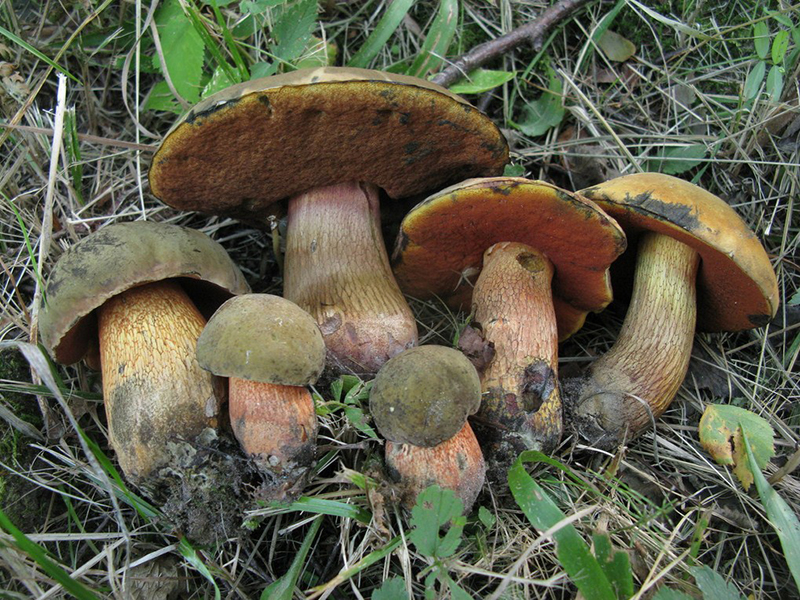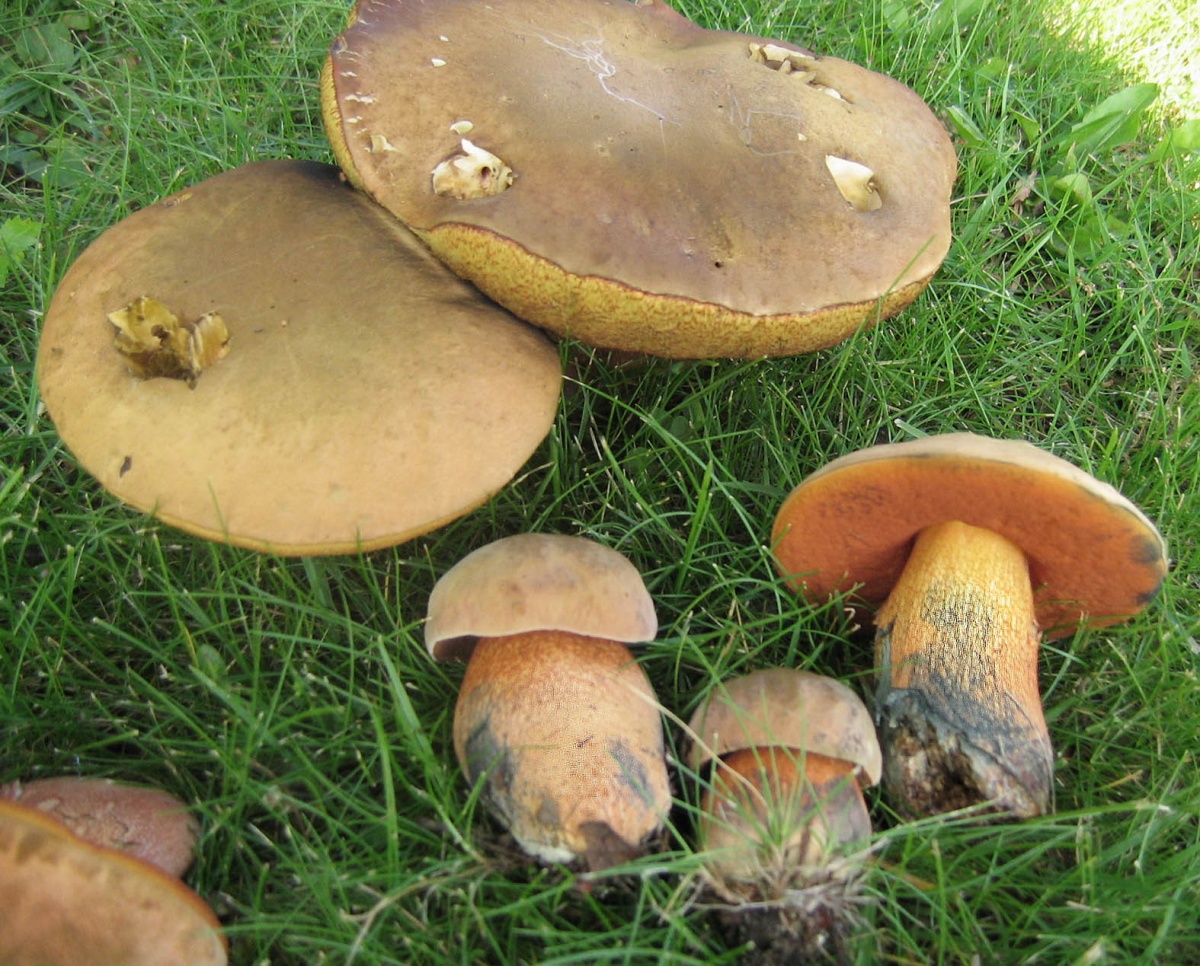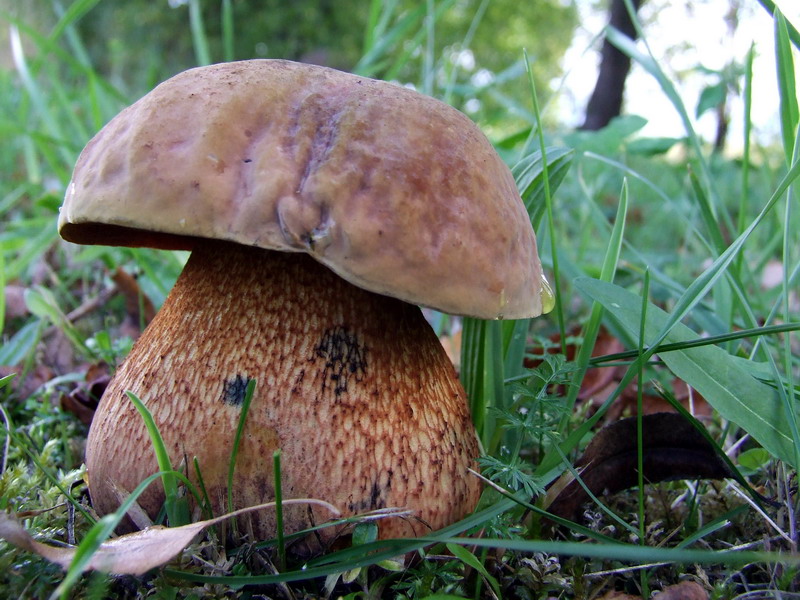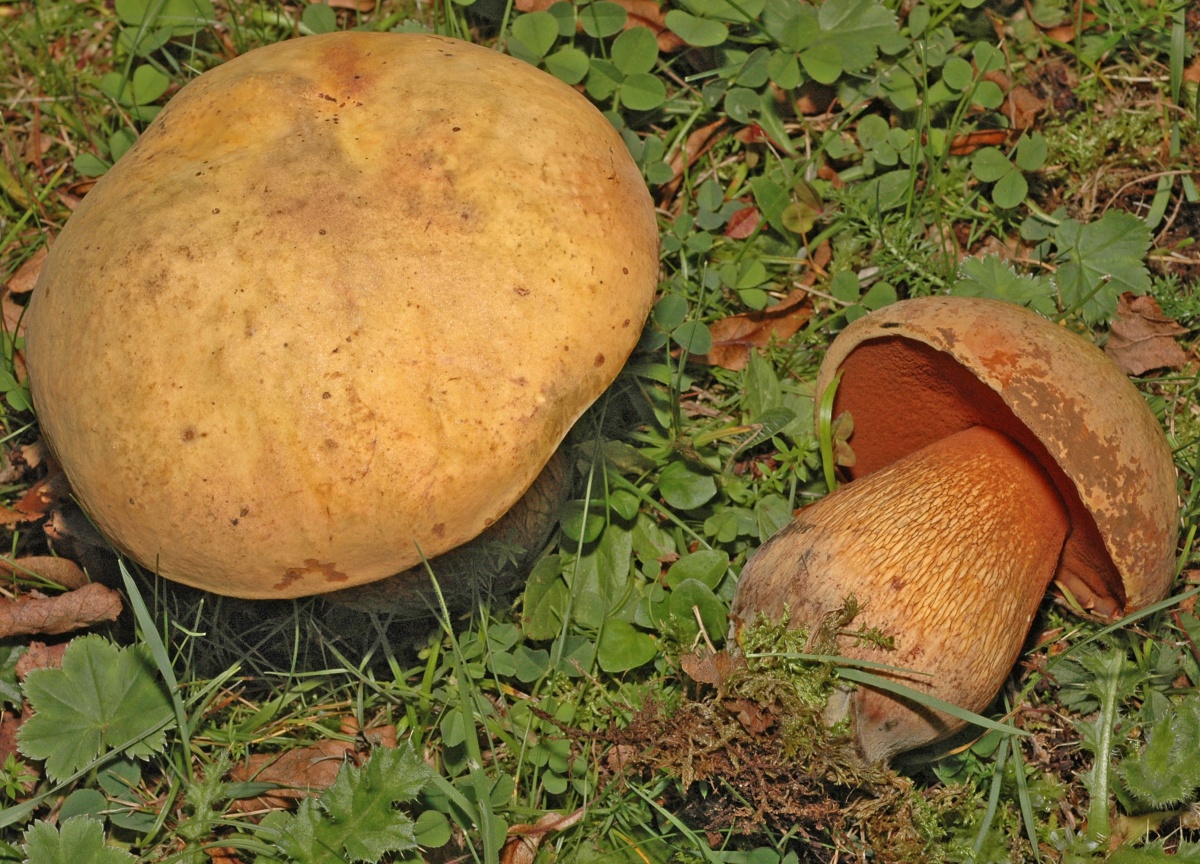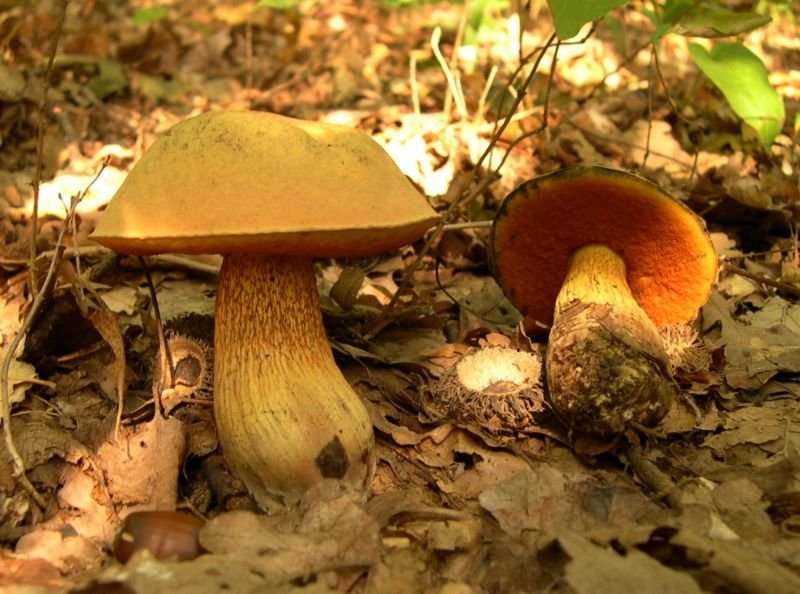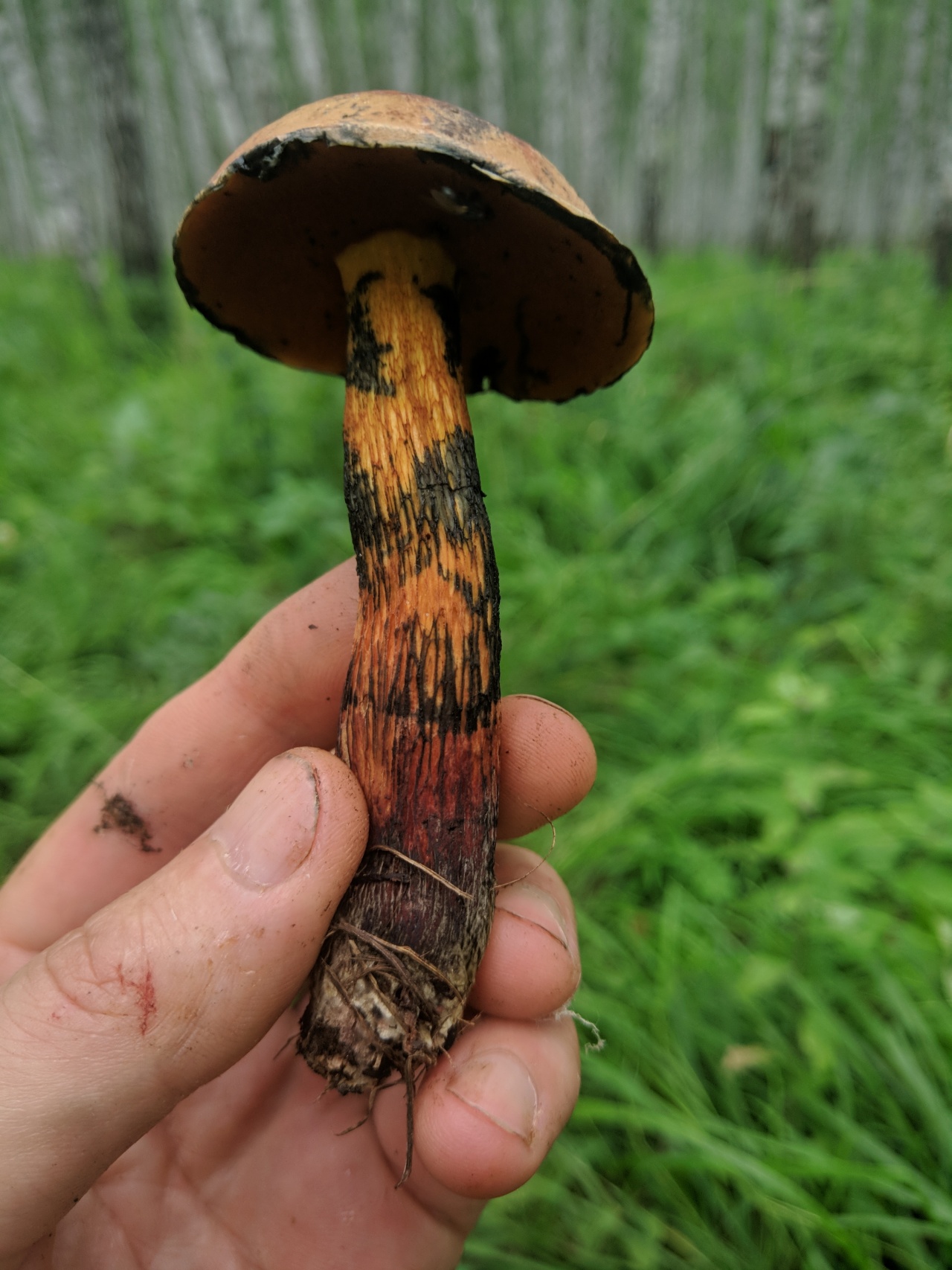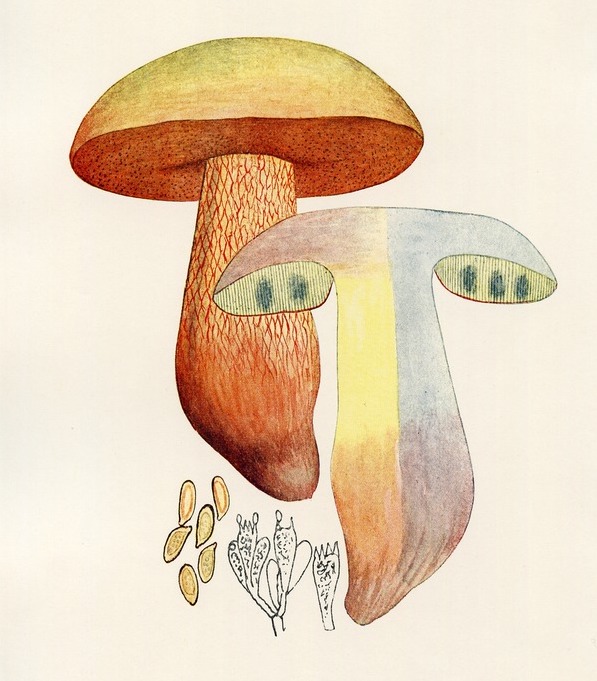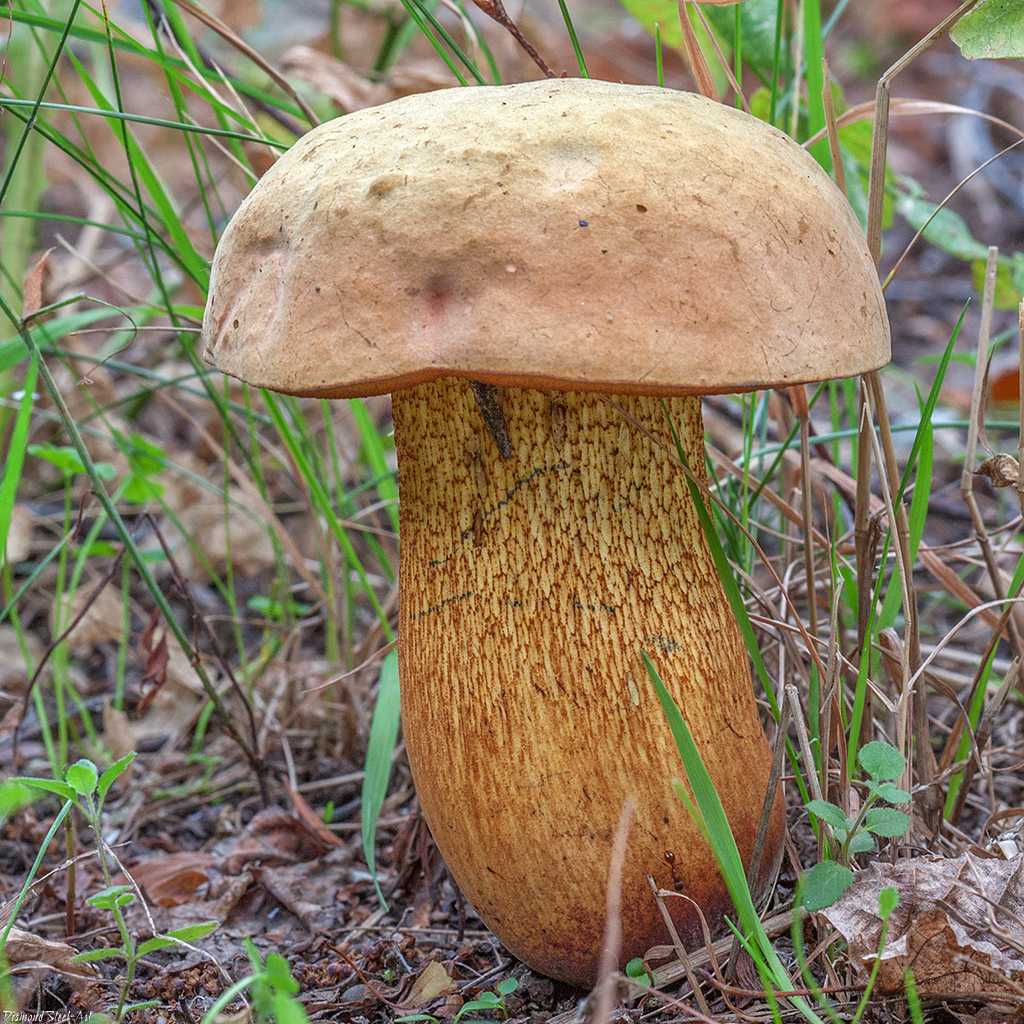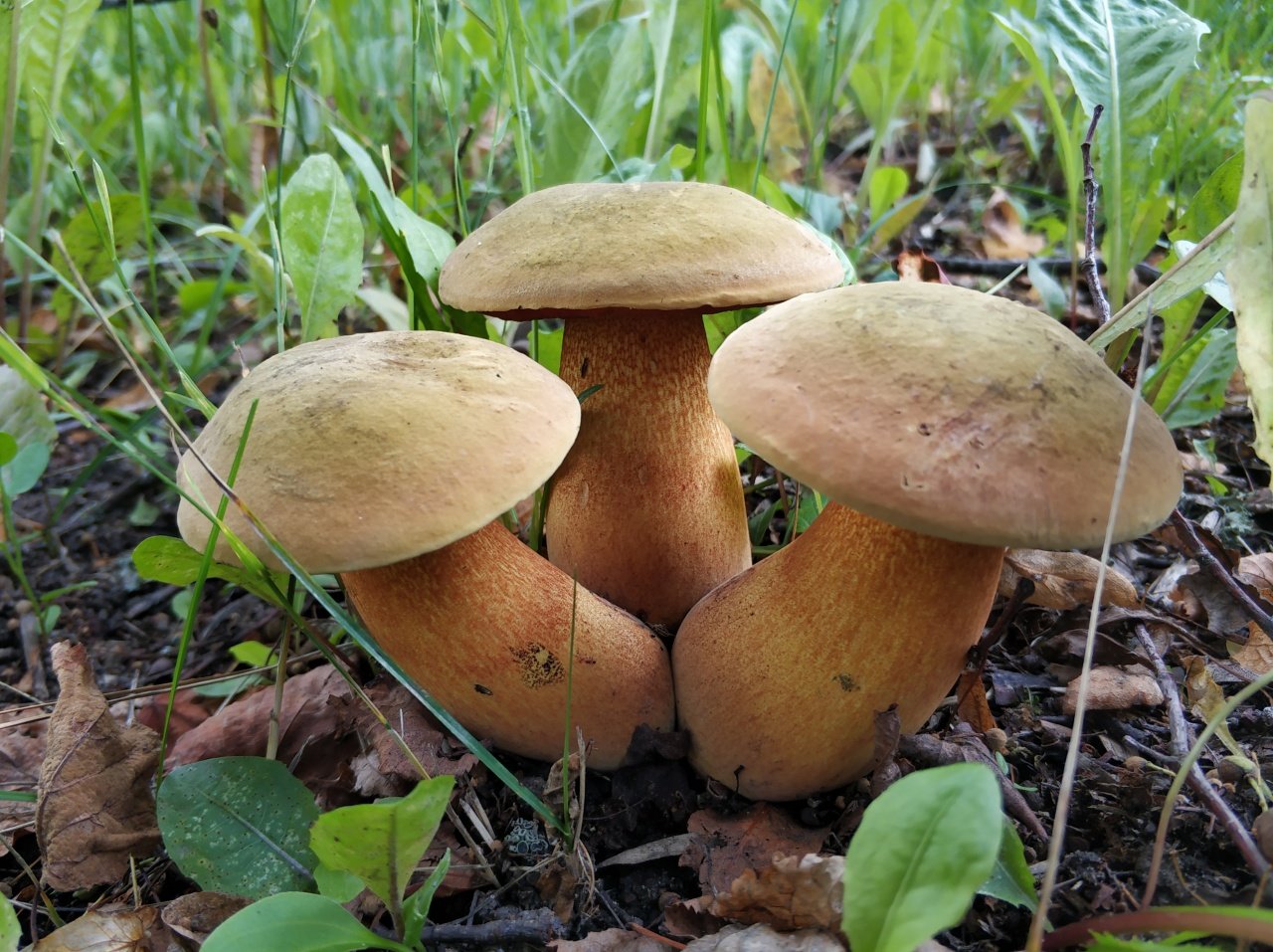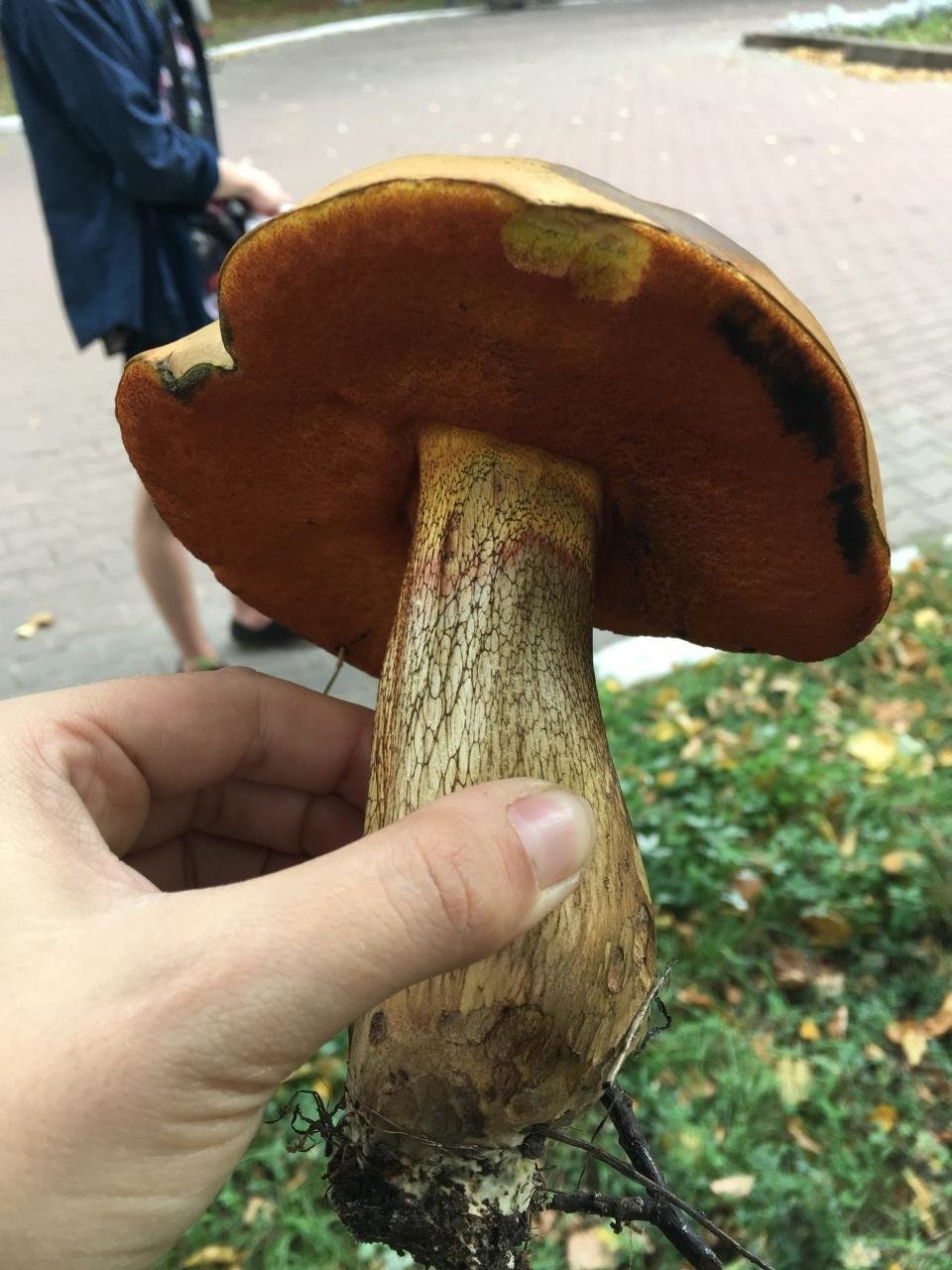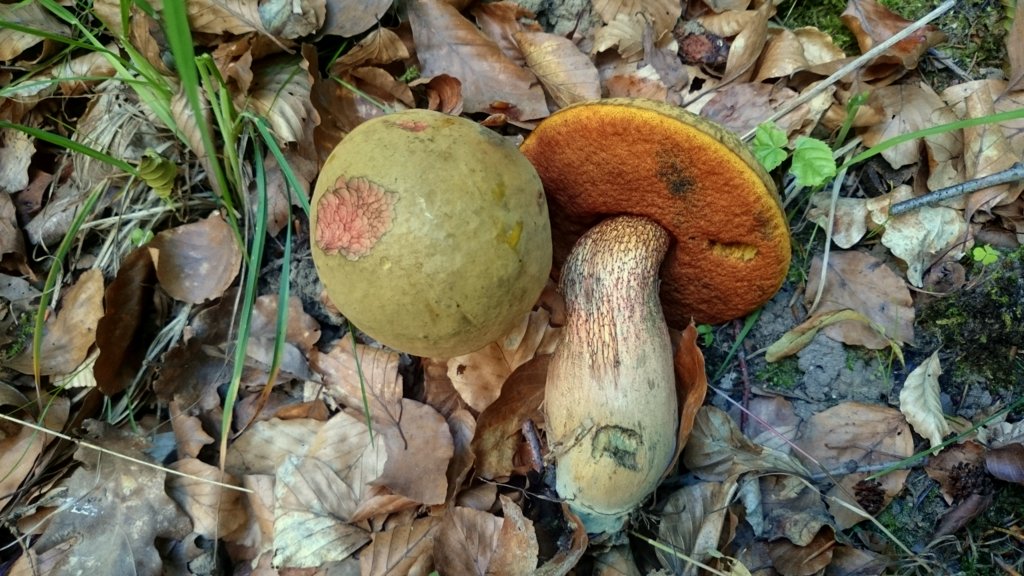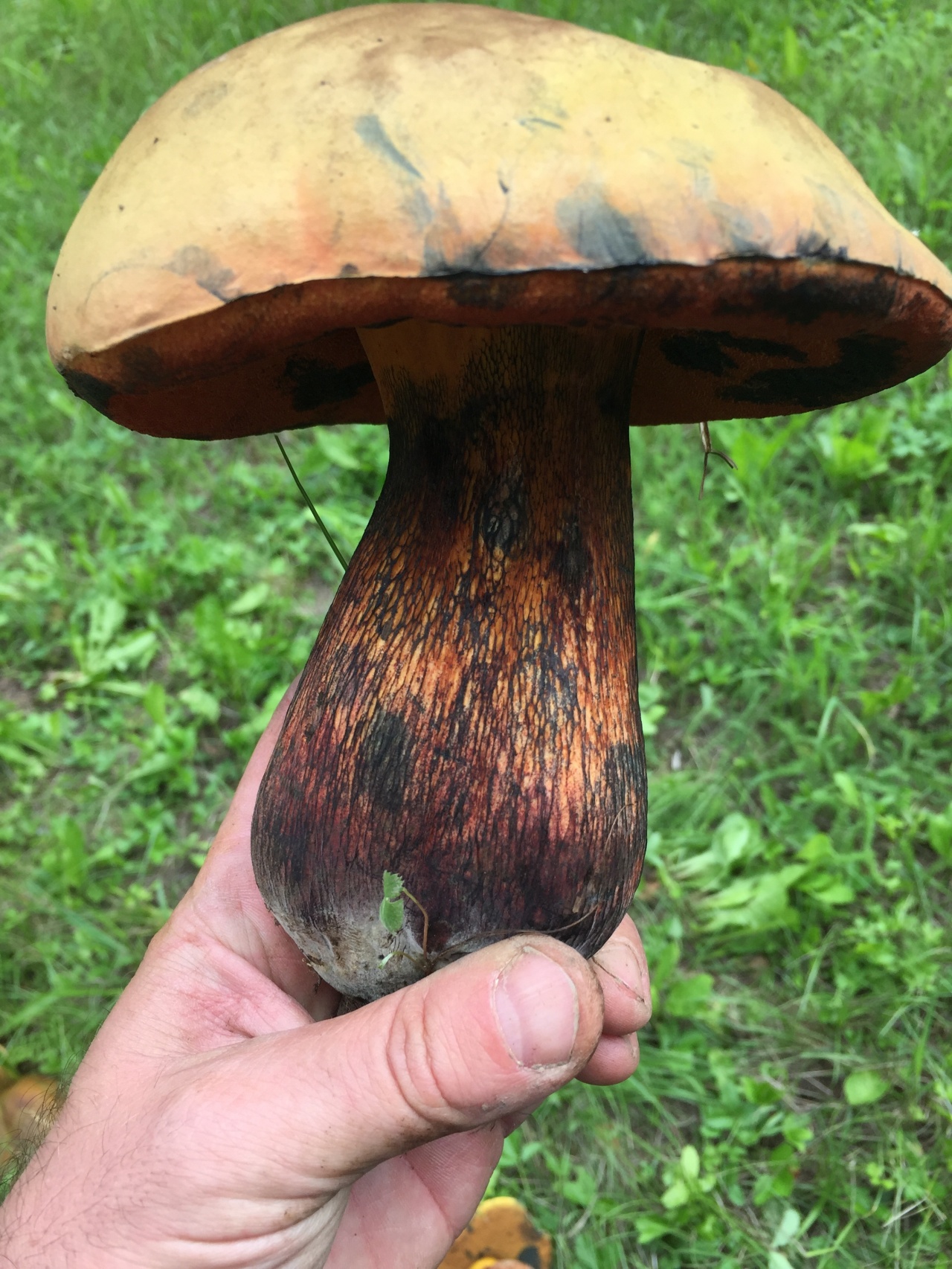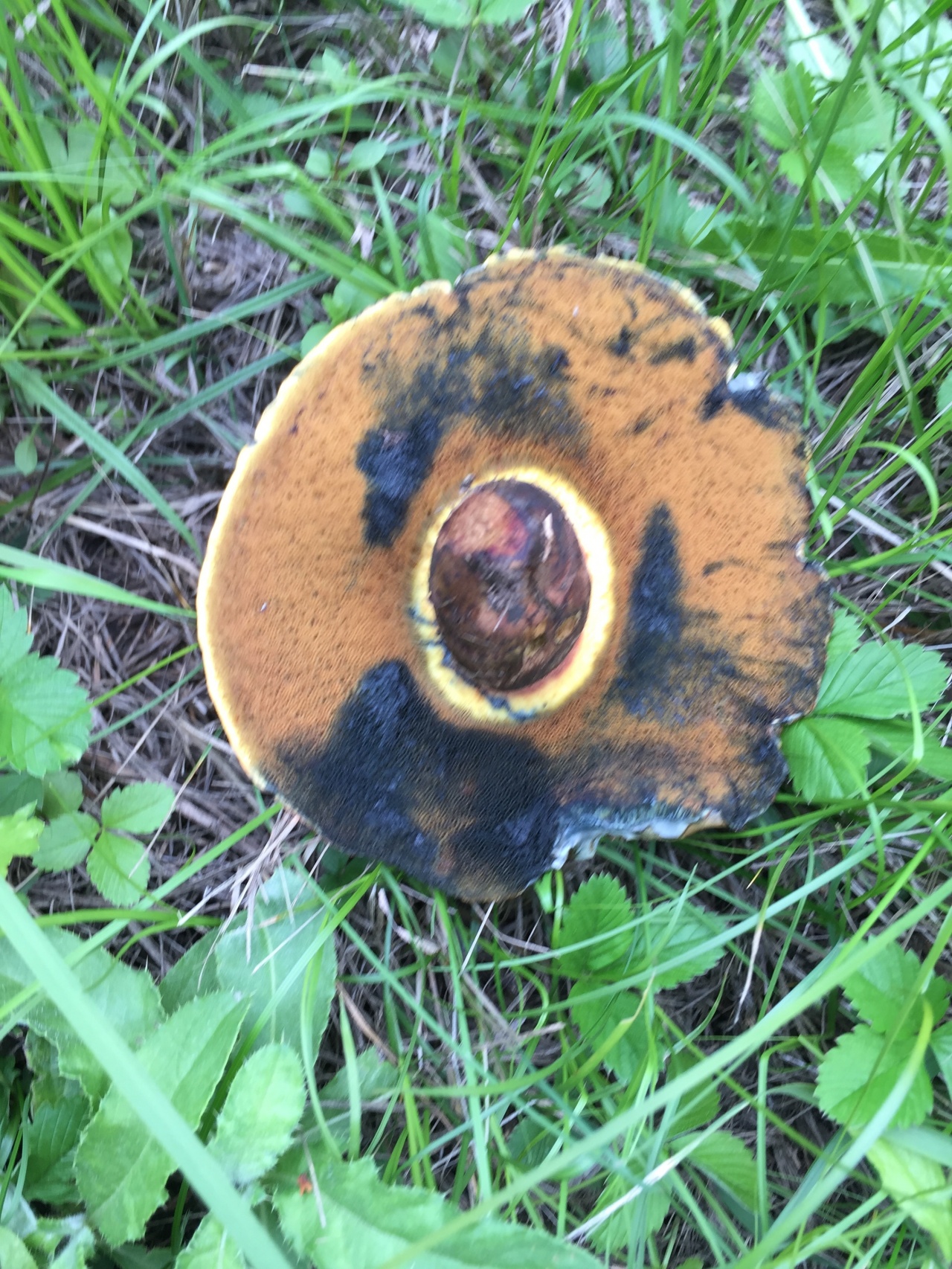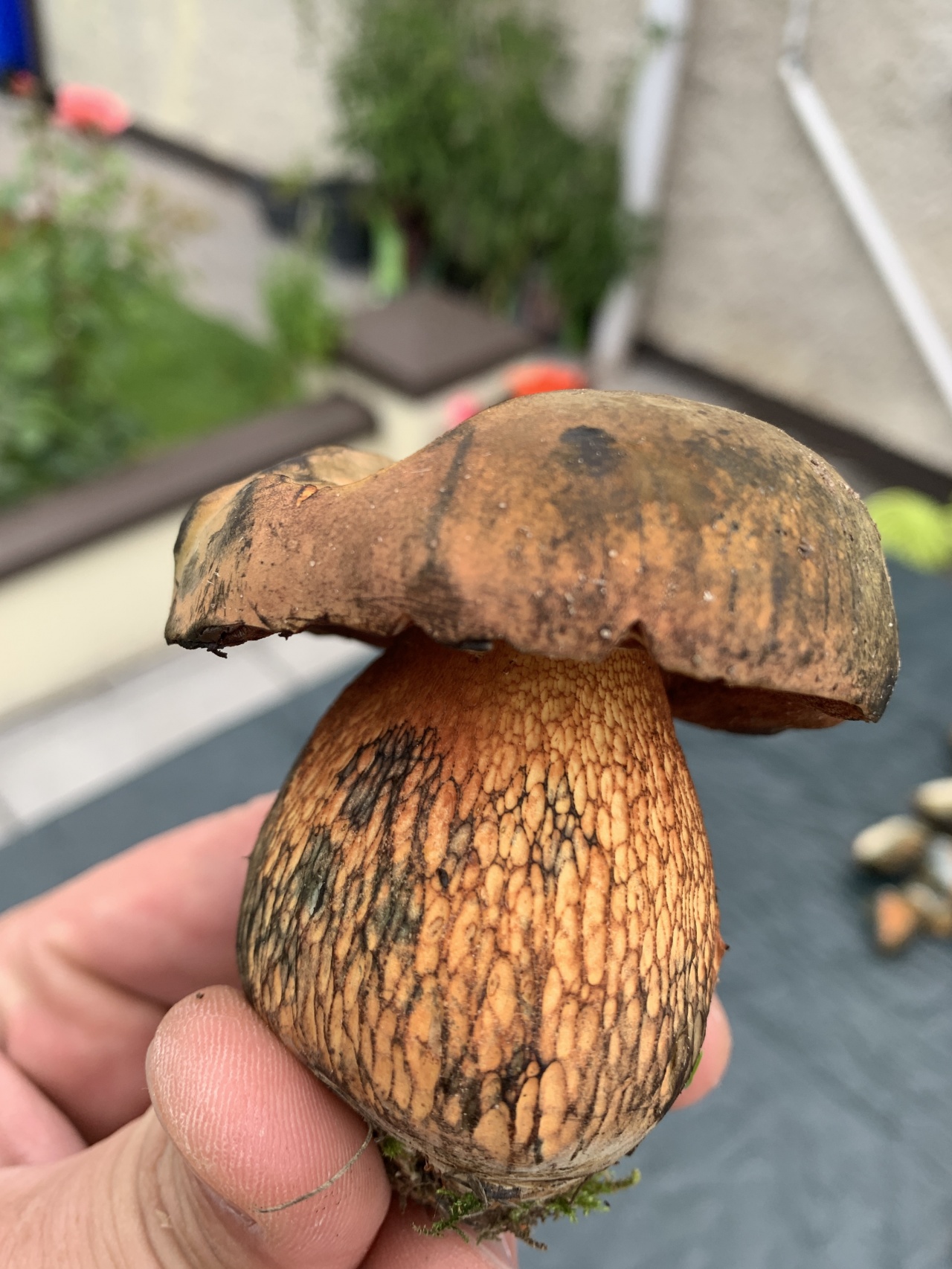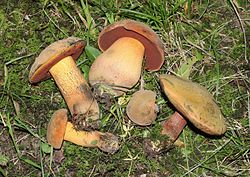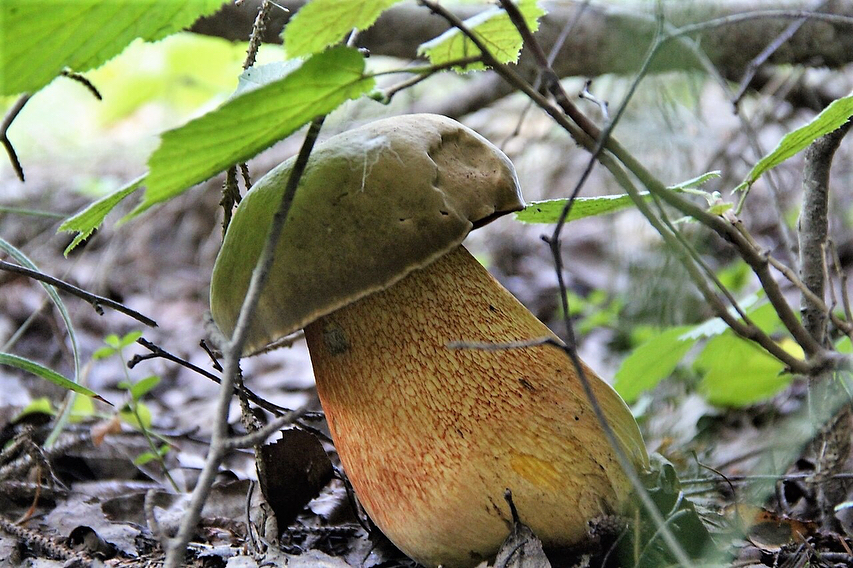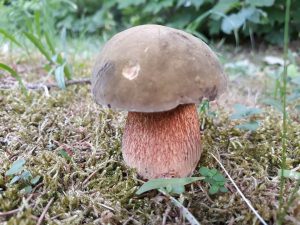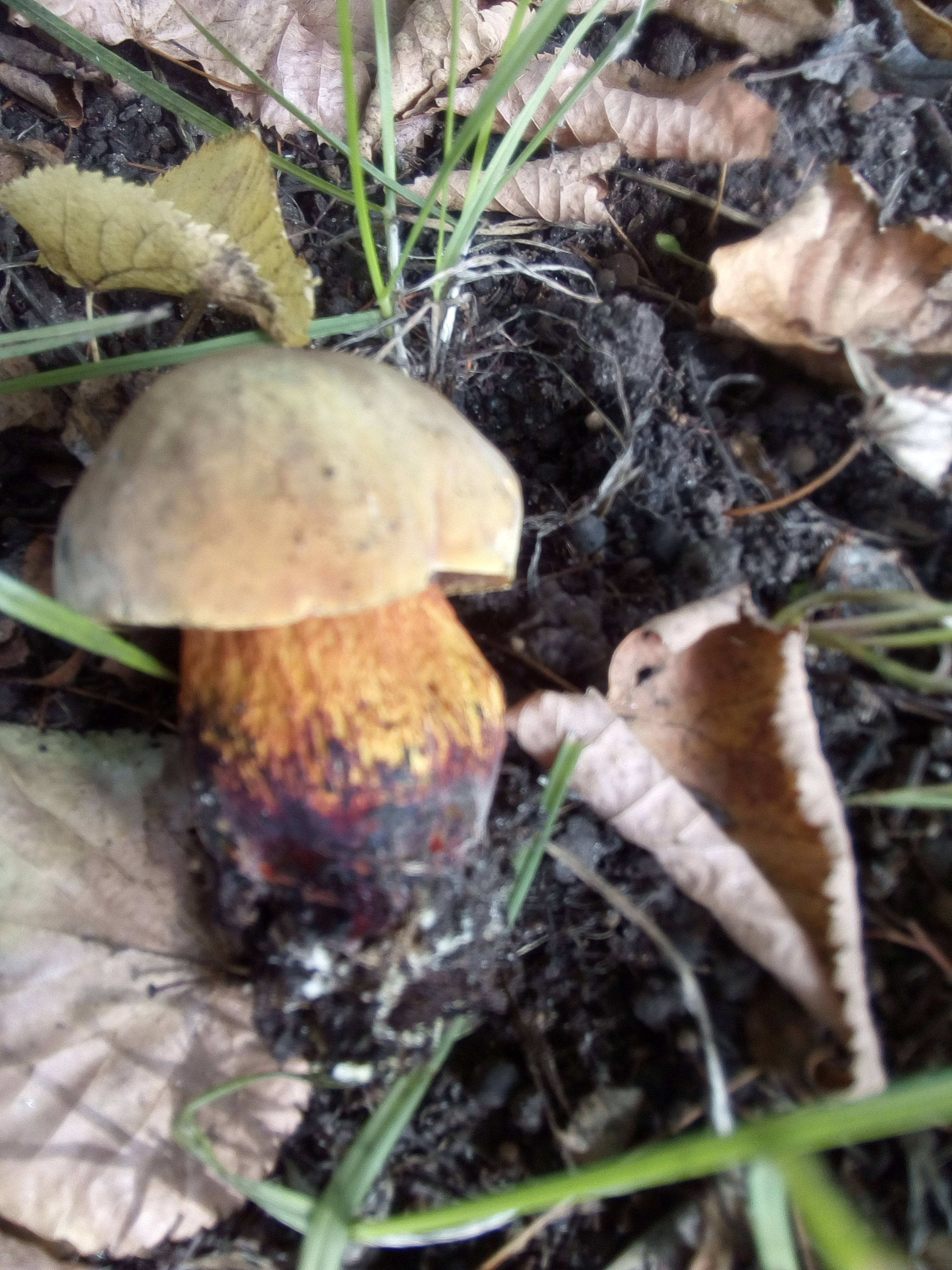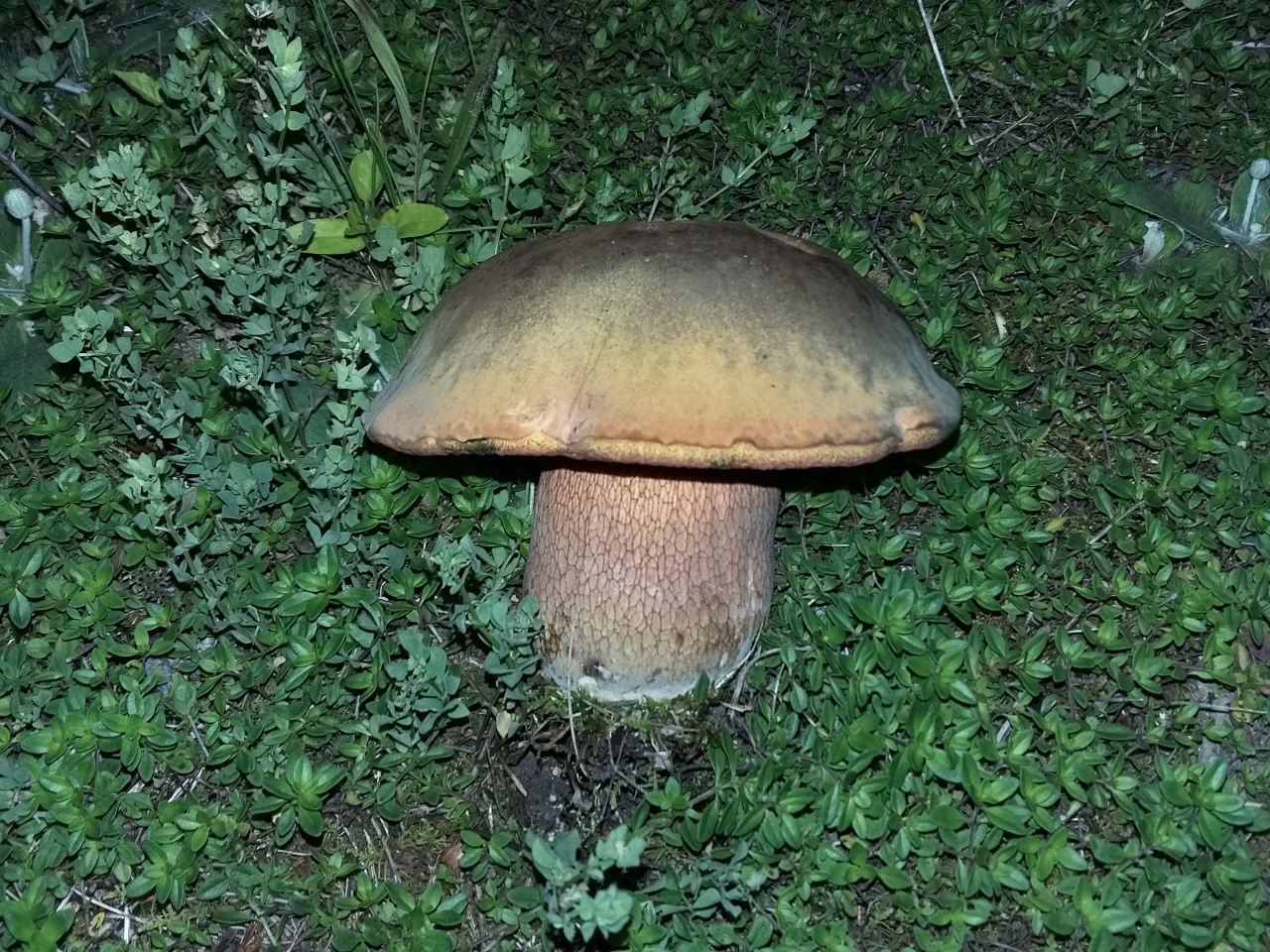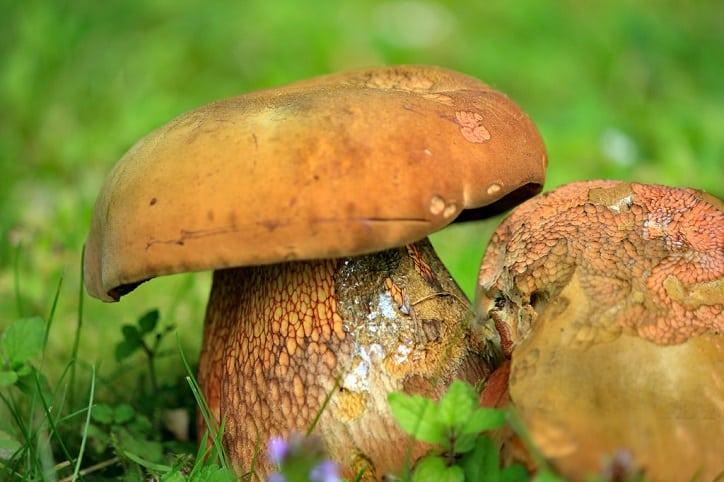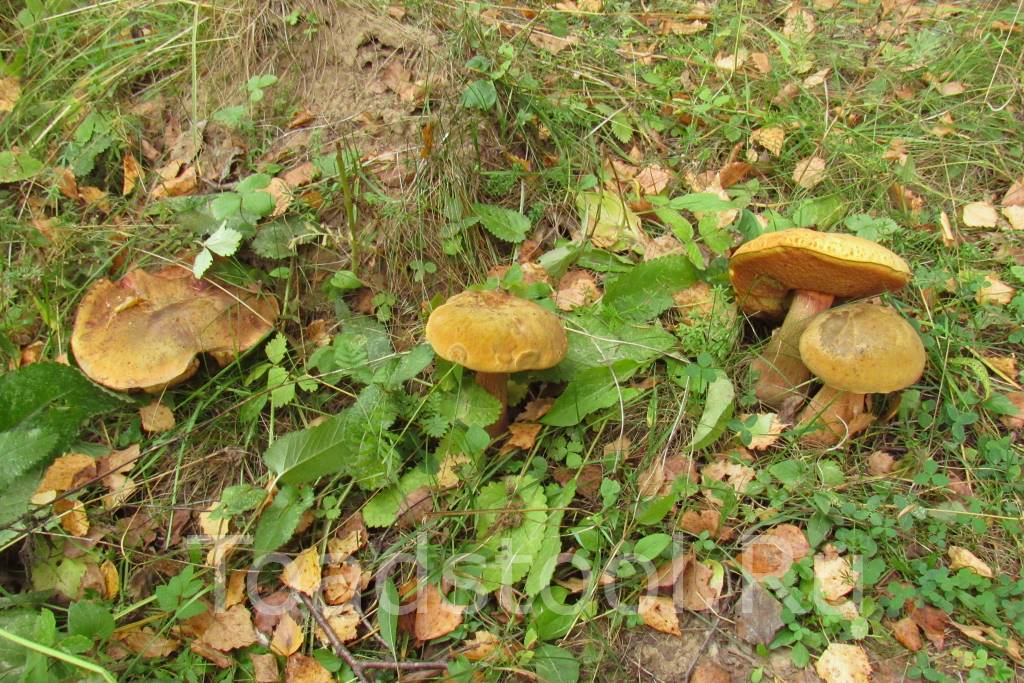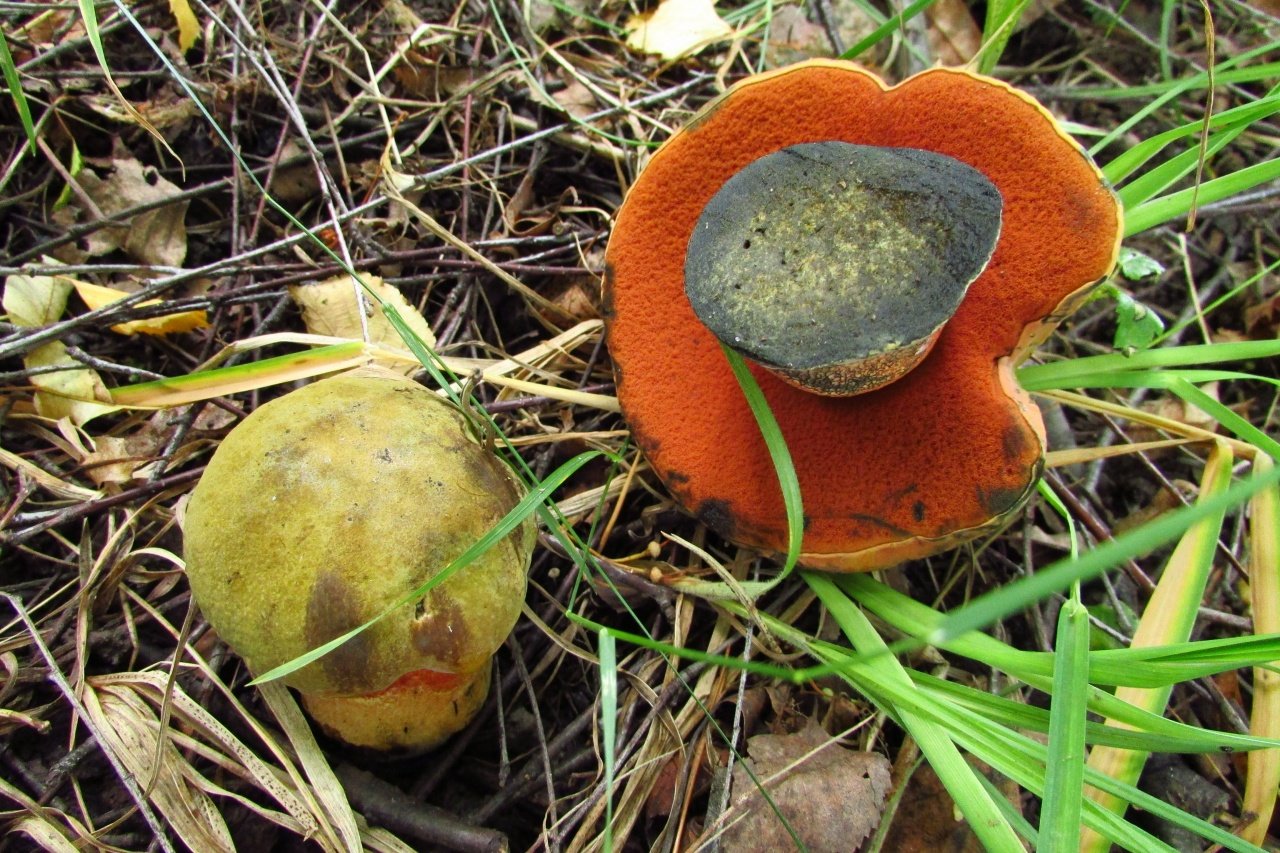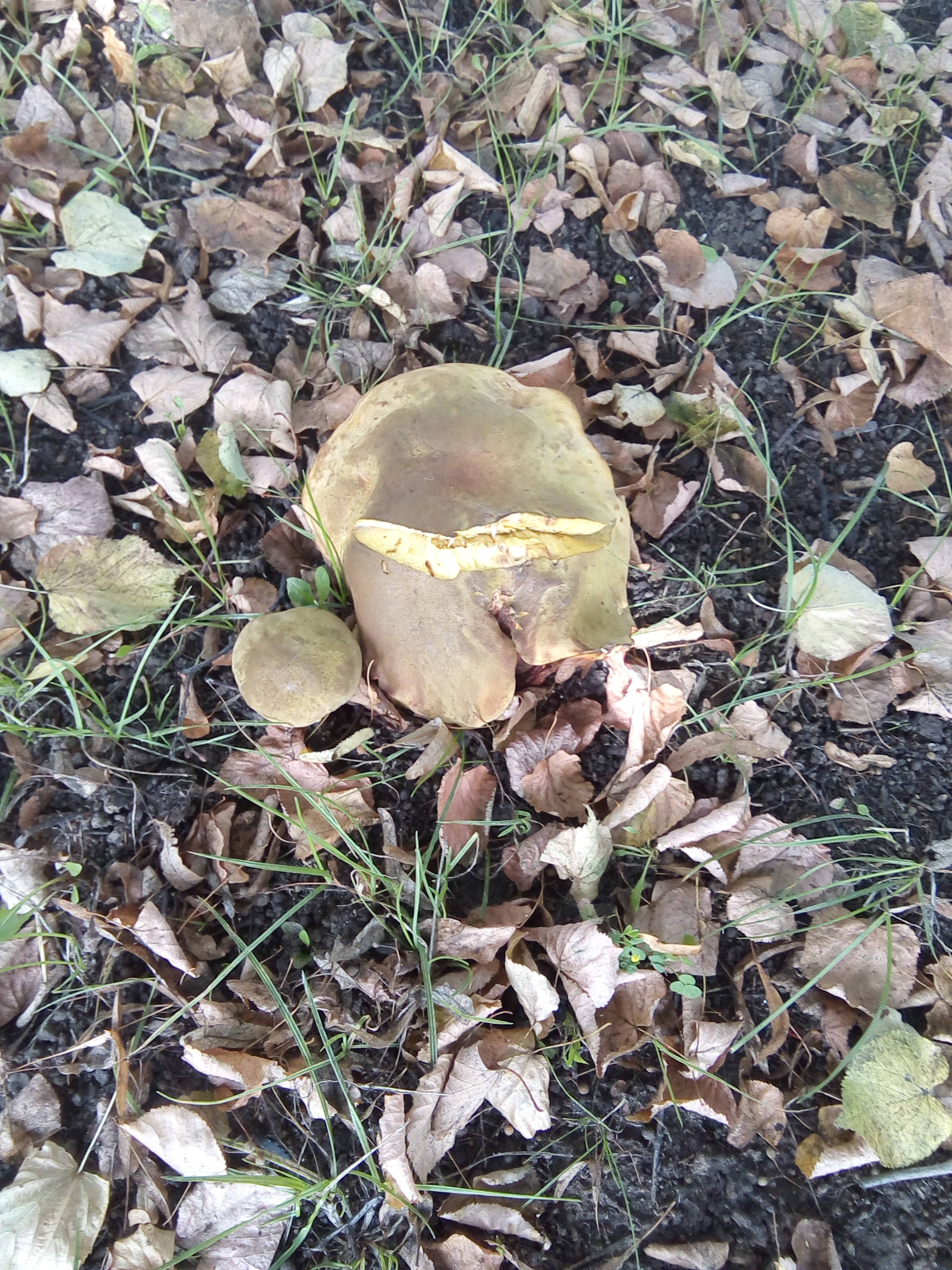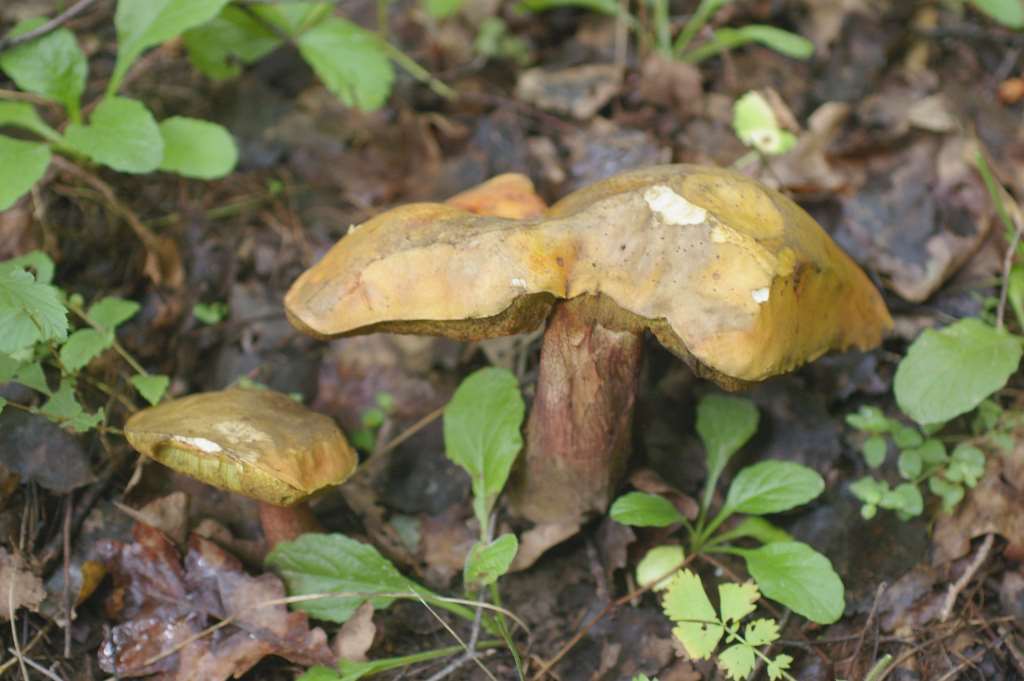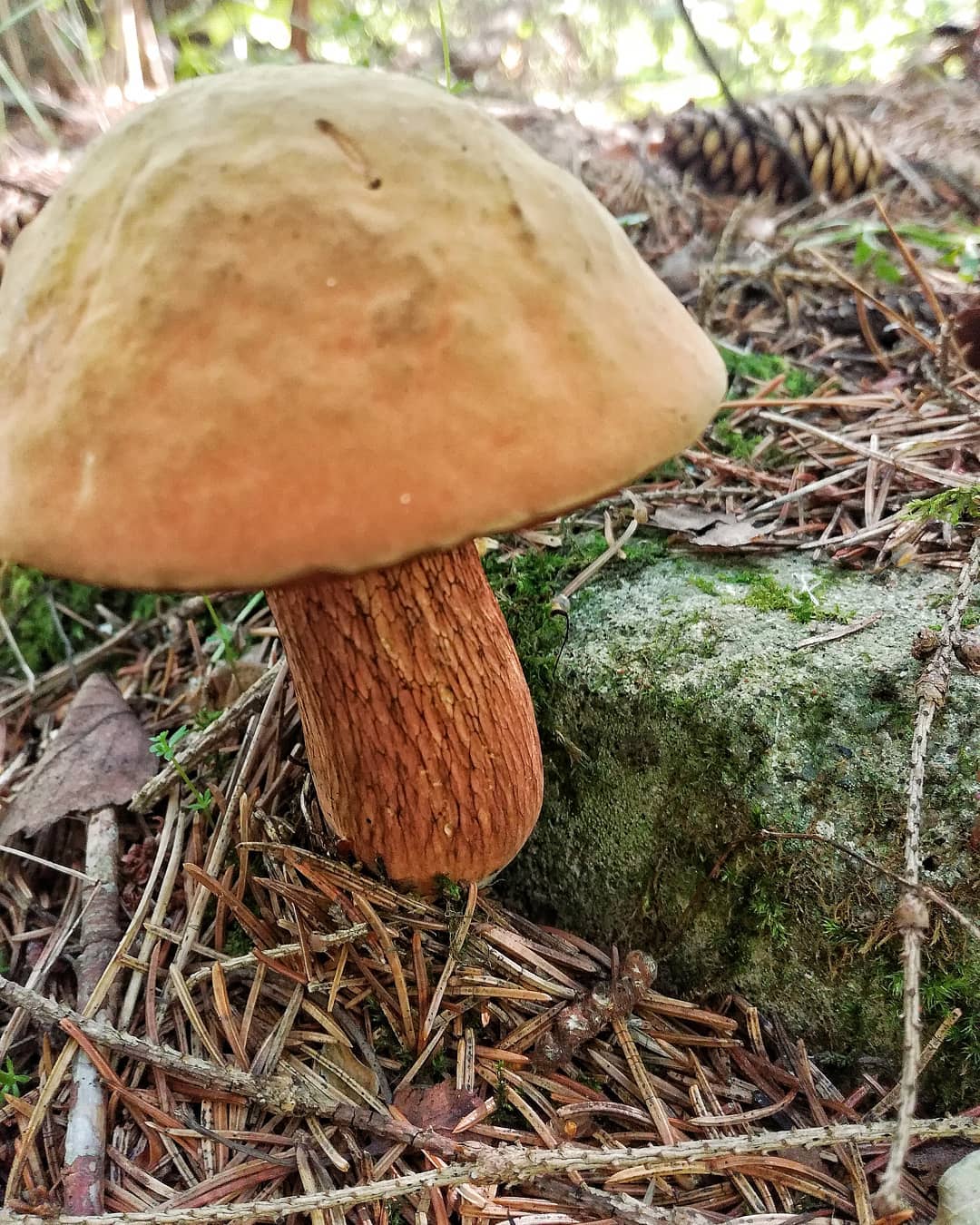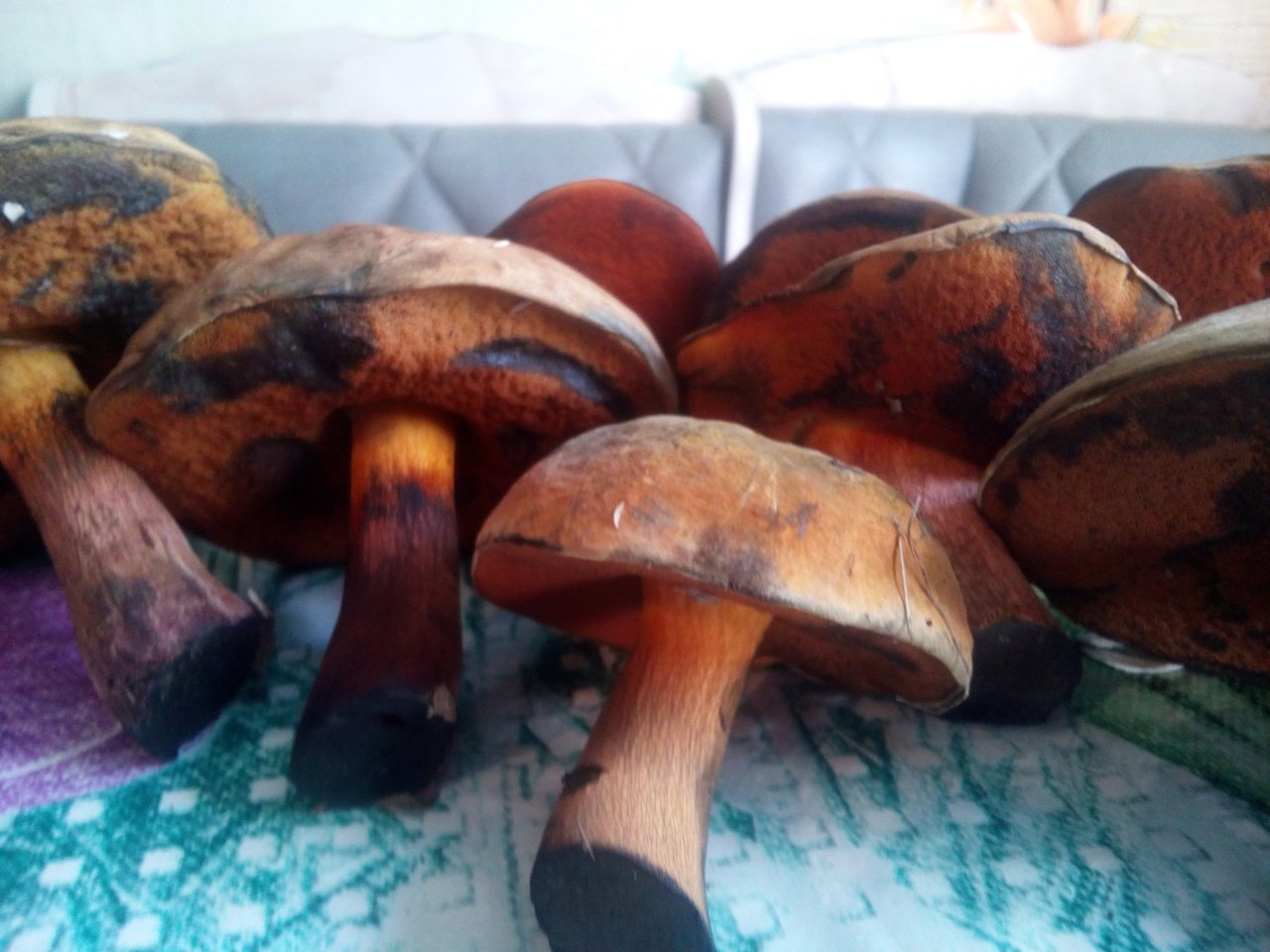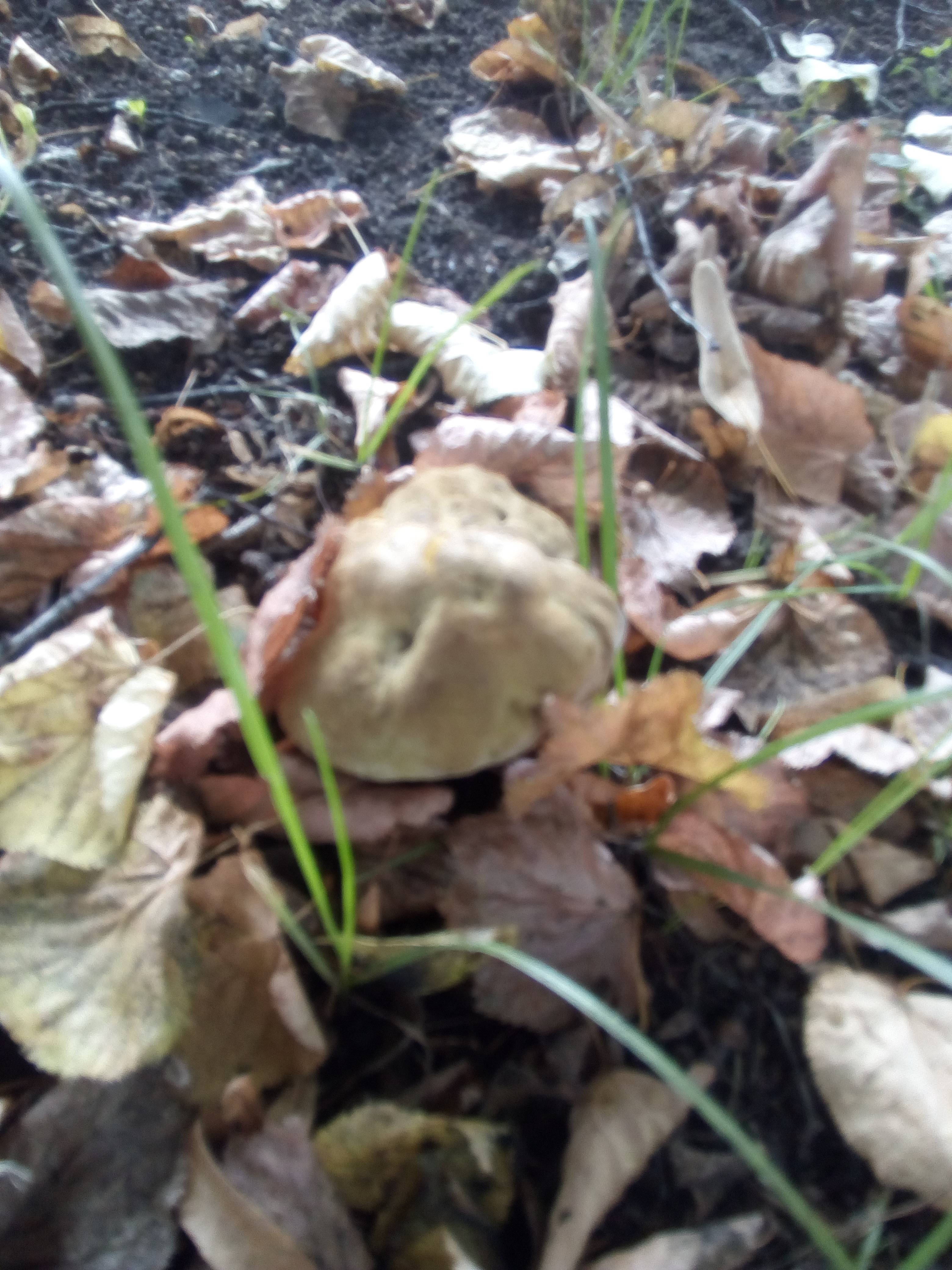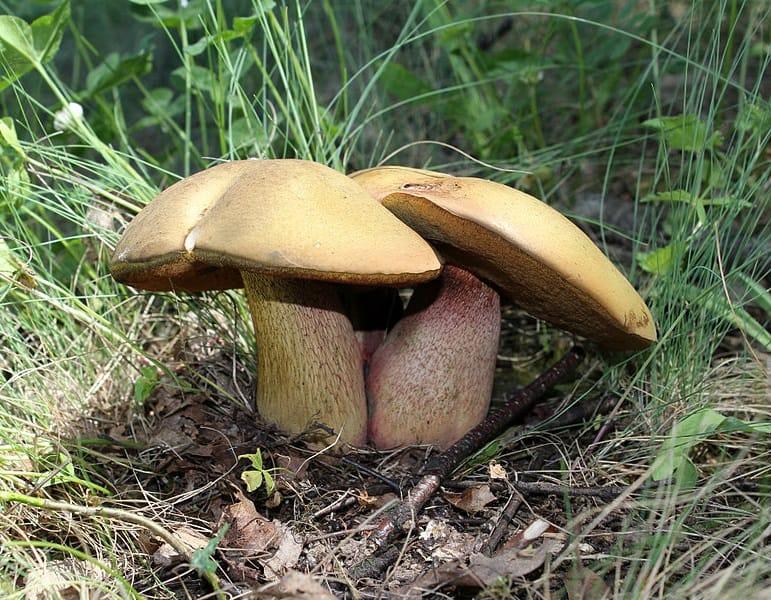What are the types of porcini mushrooms and how to distinguish them from twins (with photo)
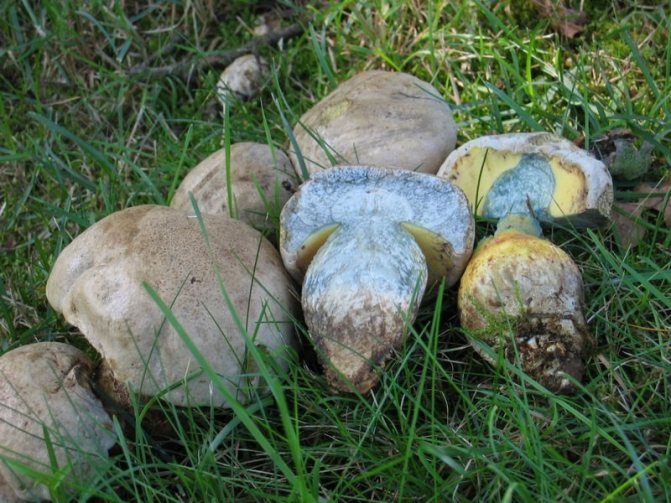
Borovik Rooting in the photo

(Boletus radicans) is inedible!
Rooting boletus (Boletus radicans) is inedible! Hat up to 30 cm, matte, white, ocher gray or with blue streaks from damage. The cap is smooth or scaly due to cracking during growth. The tubular layer is lemon yellow, then olive green. Blue color may be present due to damage. The leg is yellowish, thick, swollen, clavate. The flesh of the leg is solid, without cavities. The pulp is lemon-yellow, bitter with a faint odor, turns blue in the air.
It grows in a mixed or deciduous forest under oak or birch trees, sometimes in grass at a considerable distance from trees. Prefers calcareous or neutral soil.
The mushroom bears fruit in August and September in the form of large groups of mushrooms.
Rooting boletus can be confused with the edible mushroom blue gyroporus (Gyroporus suapepsis). How to distinguish a white mushroom from a gyrovorus? Gyroporus cyapepsis) has air cavities inside the stem and, unlike Boletus radicans, tastes good.
The mushroom is not poisonous, but the bitterness of rooting boletus is so great and unpleasant that, once it gets to edible mushrooms, this mushroom will ruin any dish.
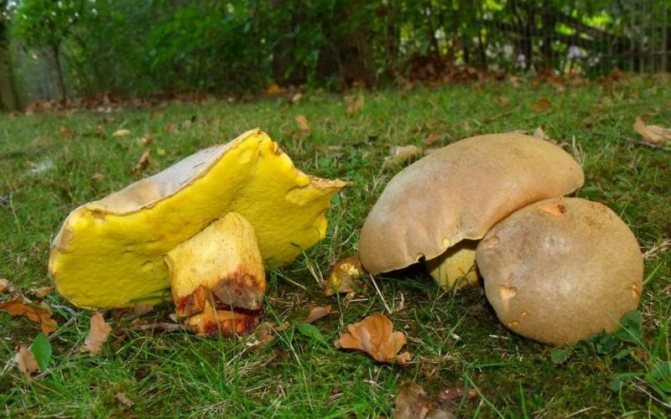
Boletus Yellow in the photo
Boletus yellow (Boletus impolitus) has a cap from 4 to 20 cm in diameter, grayish-yellow or yellow-brown. The pores are yellowish, yellow, olive with age. Spores 12-14 × 4-6 µm, yellowish. The spore mass is olive-brown.
Pay attention to the photo - in the porcini mushroom (boletus) of this species, the leg is dirty yellow, sometimes brown-red to the base, granular, without a mesh:
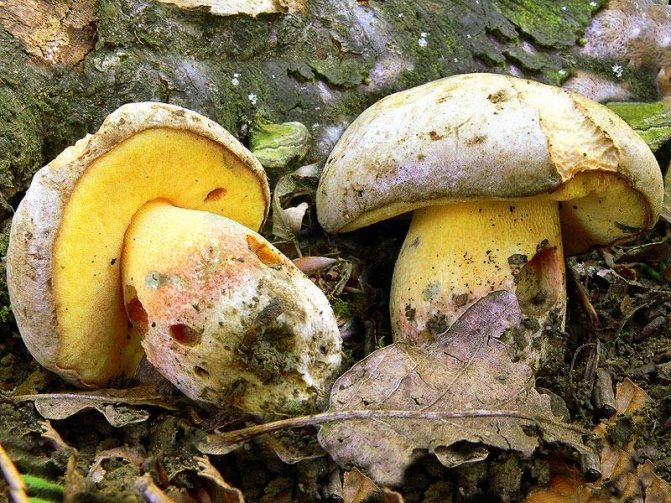
The pulp is dense, yellowish, yellow above the tubes, when cut, its color does not change, it tastes good.
Distributed in Polesie, Carpathian and forest-steppe. Grows in deciduous and mixed forests, under an oak tree. Fruiting: July - October.
A very good edible mushroom. Eaten fresh, pickled, can be dried.
The similarities and differences are the same as those of the porcini mushroom.
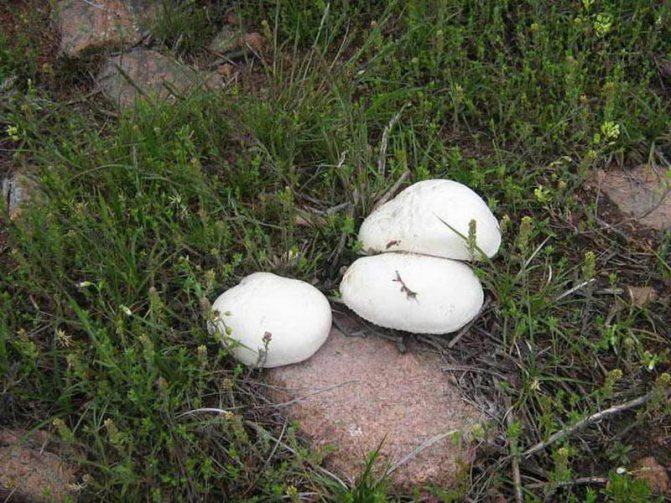
White Steppe mushroom in the photo
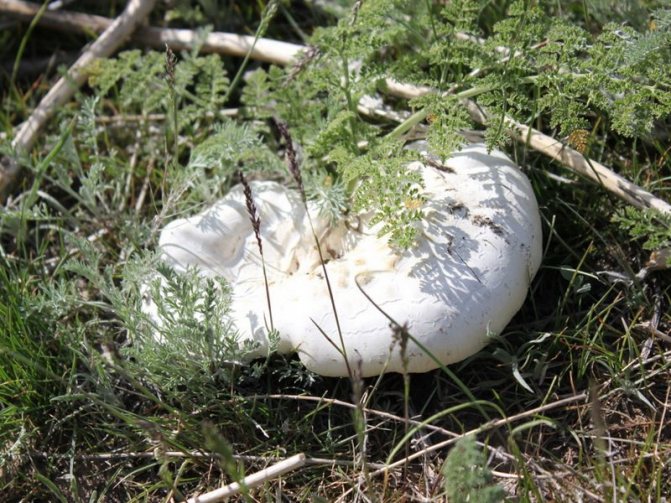
The cap of the steppe mushroom has a flat-convex shape
The white steppe mushroom is edible, lamellar. Grows in groups. Places of growth - the steppe regions of Central Asia, Uzbekistan, the Caucasus. The first mushrooms appear in early spring, but the peak of fruiting occurs in the middle of summer.
The white steppe mushroom fully justifies its name: its entire fruit body is painted in an even white color. In young mushrooms, the cap has a flat-convex shape, but with age it becomes funnel-shaped or acquires a small depression in the center. The diameter of the cap is 6–8 cm. On its inner side, there are descending plates containing colorless spores of an elongated-oval shape. The stem of the mushroom is straight, even, slightly narrowed at the bottom. The pulp is fleshy, dense, juicy, almost odorless.
The spruce cep has a brown, reddish-brown or chestnut-brown cap and a long stem. Grows in spruce forests from the second half of July to the end of August.
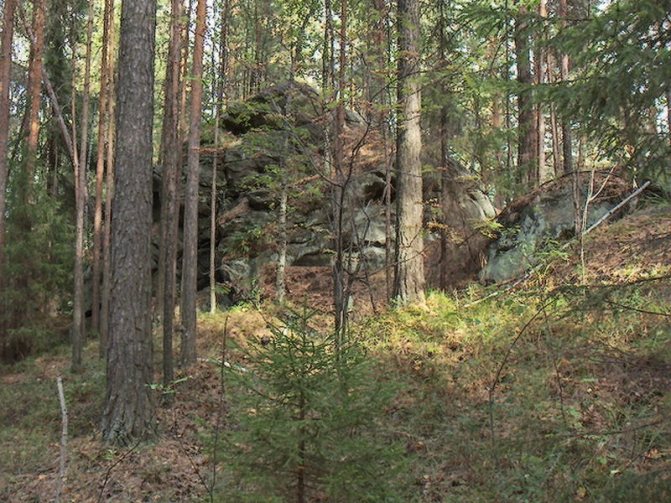
Pine forest with mushrooms

Pine porcini mushroom in the photo
Pine porcini mushroom (boletus) has a dark brown cap with a reddish tinge and a short thick leg. Grows in pine forests from mid-June to mid-October.
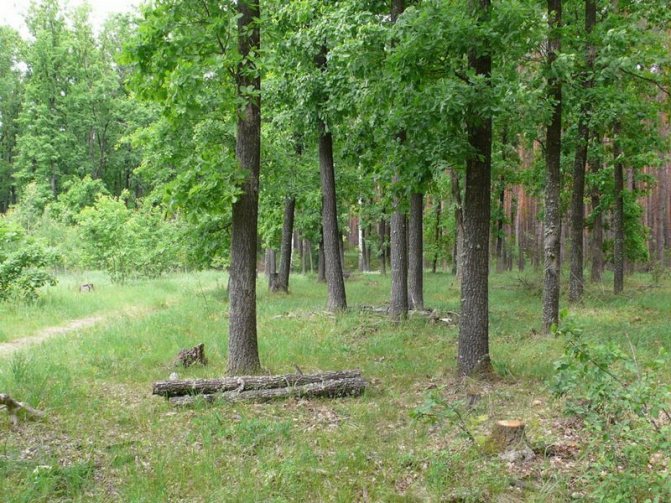
Oak forest with mushrooms
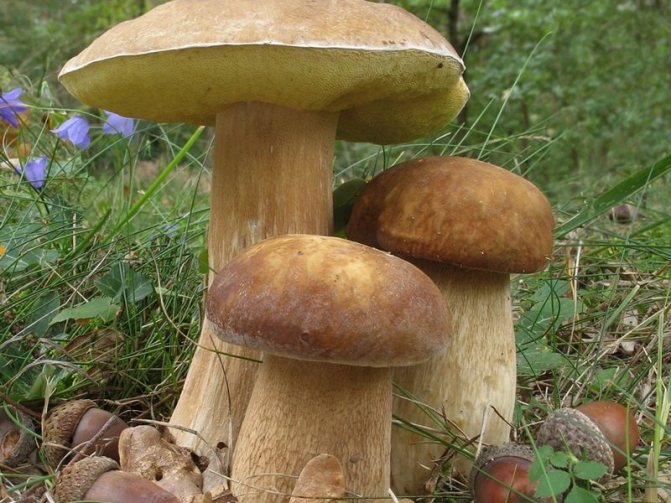
Oak porcini mushroom in the photo
The oak porcini mushroom has a greyish-brown cap and long stem, as well as a looser flesh than the previous varieties. Grows in oak forests from early July to early October.
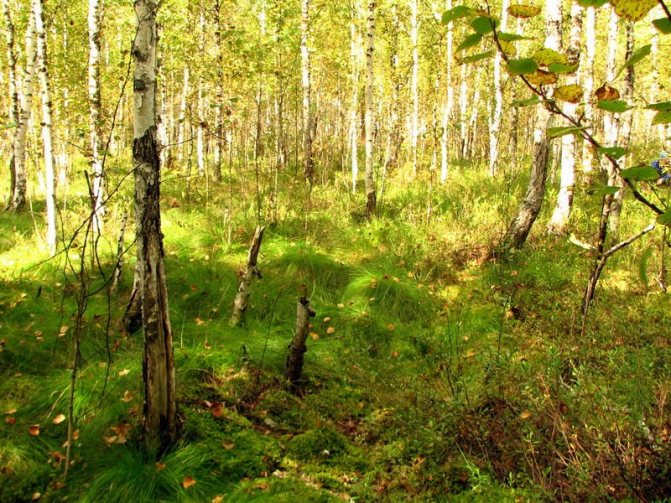
Birch grove with mushrooms

White birch mushroom in the photo
White birch mushroom can be recognized by its light brown or yellowish brown cap and short tuberous stem. Grows in birch forests from early July to mid-October.
Here you can see photos of porcini mushrooms, the description of which is presented above:
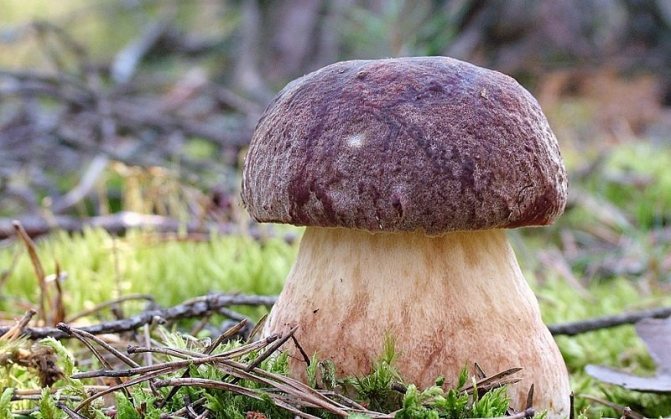
Pine cep (Boletus pinicola) pictured

White oak mushroom in the photo
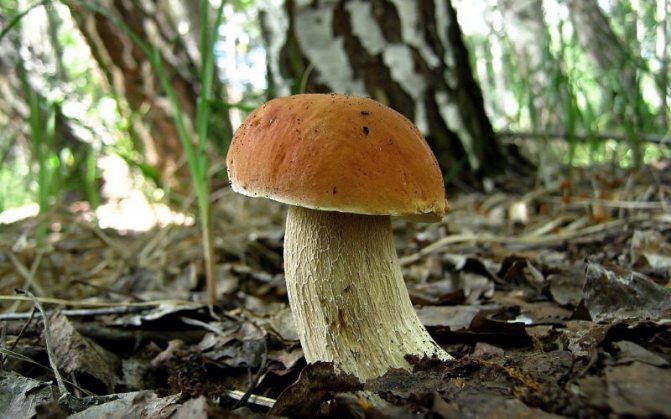
White birch mushroom in the photo
The next section of the article is devoted to how to grow porcini mushrooms in the garden.
Primary processing and options for the preparation of oak wood
First of all, the fresh crop must be boiled in salted water for 10 minutes. Then strain the mushrooms, rinse in clean water, add water again and put on fire. After 20 minutes, the mushrooms should be removed. This process of processing mushrooms is very important, as it allows you to remove toxic substances from the fruit. In case of violation of the rules, an hour after eating undercooked mushrooms, the person begins to show symptoms of poisoning.
For pickling mushrooms, you need to prepare a marinade at the rate of 200 ml of water: garlic (3 cloves), bay leaf, black pepper (5 peas), dill sprigs, cloves, 1 tablespoon of sugar and the same amount of sea salt. Boil water with all ingredients added for 5 minutes. Next, 1 kg of oak wood is placed in the container, and the composition boils for another 5 minutes. After that, the mushrooms should be laid out in jars, add vinegar on top and carefully cork.
To cook potatoes with mushrooms, the prepared fruits must be fried with onions and combined with finely chopped potatoes. Then pour sour cream over everything and place in the oven. For flavor, sprinkle with spices and chopped garlic on top.
Tags: mushroom
Mushroom Sites Map
In 2020, the Belgorod region will delight you with a bountiful harvest in both pine and mixed forests; a special map will help you find mushroom spots.
- For mushrooms, chanterelles and russula go to Shebekinsky, Graivoronsky, Valuysky districts.
- For porcini mushrooms - to the Borisov district and to the oak forests, beyond Biryuch.
- For boletus - in deciduous and mixed forests of Valuisky and Belgorodsky districts.
- For honey mushrooms and boletus - in the Novotavolzhansky pine forest.
- In the forest of the village of Striguny, there are a lot of boletus, camelina, boletus, boletus. Here mushrooms appear earlier.
- In the pine plantations of the village of Prokhorovka, boletus and mushrooms grow.
- In Novosadovo, after the rain, it will be possible to collect russula, porcini mushrooms and boletus.
The benefits and harms of oak tree.

Oak mushroom is an indispensable product for those people who are on a dietary or vegetarian diet. Fresh mushrooms contain high concentrations of potassium and sodium compounds. In the process of cooking, the concentration of these valuable substances is partially reduced, but they are still enough to meet the needs of the body.
In addition, the oak tree is rich in iron, which is essential for maintaining healthy hemoglobin levels in the blood. Mushrooms contain saturated fatty acids and magnesium - substances through which the nervous system and other organs are restored and functioned. Among other things, the pulp of the mushroom is saturated with vitamins, including tocopherol, retinol, ascorbic acid, and some B vitamins.
Despite the fact that the oak mushroom is so healthy, it can still pose a health hazard. Any mushrooms, including oak tree, cannot be used for gastritis, stomach and intestinal ulcers, as well as during pregnancy and the period of breastfeeding.
Dubovik is a valuable mushroom, which in composition and taste is quite capable of competing with other representatives of the Borovikov genus.
With the right precautions and proper preparation, the mushroom will only benefit!
Contraindications
The main difference between a poisonous mushroom is an unpleasant pungent odor and a grayish-green tint at the cap. Even at the break in the oak tree, the flesh becomes a distinctly blue color, in the poisonous satanic one it turns blue and quickly recovers again.The legs are also different: in a poisonous mushroom, it is thick and tuberous, with a reddish reticular pattern, in an oak tree there is either no mesh on the leg, or it is brownish-pink.
In addition, it should be noted that, in general, mushrooms are a rather specific food that contains natural chitin, which brings considerable benefits to the body. But children under 12 years of age do not yet have enzymes capable of assimilating such a substance. In this regard, it is better for children to limit the intake of dishes containing mushrooms.
In any case, mushroom pickers should always remember about careful preliminary boiling (followed by draining the liquid). If the mushrooms are poorly cooked, they can cause some digestive upset.
Precautionary measures.
When picking mushrooms in the forest, you need to be extremely careful, since often the edible species have false counterparts, which practically do not differ in appearance, but in composition can be hazardous to health. Dubovik is no exception. In the forest zone, a false twin of this mushroom is periodically found. Satanic mushroom is the popular name for a poisonous mushroom that has a striking resemblance to an oak tree. How can you tell a toxic mushroom from an edible one?
- Firstly, the satanic mushroom differs from the edible oak tree by a sharp reddening of the pulp, a pinkish tint of the leg.
- Secondly, in satanic mushrooms, the shape of the leg is different - it is slightly shorter, rounded - in the shape of a barrel or even spherical.
- And thirdly, edible oak wood in its raw form has a very weak but pleasant aroma, and the satanic mushroom gives off a smell of dampness and rot.
The problem is that this poisonous analogue is practically not studied and the exact composition is still unknown to science. But, the good news is that it is extremely rare, but this does not give the mushroom picker the right to lose vigilance!
How to distinguish boletus from satanic mushroom (video)
Going into the forest, you need to know the distinguishing features of edible mushrooms from poisonous representatives, especially from doubles. Dubovik has a very similar congener, which is called the Satanic mushroom, forbidden for human consumption. Despite the apparent similarity in appearance, there are still significant differences:
- The edible representative has a dark brown or reddish cap, in contrast to the light dirty yellow color of the poisonous specimen;
- The yellow pulp, upon contact with air, changes color, becoming blue. The grayish flesh of the satanic mushroom at the break point first turns red and then blue. In this case, the fruit exudes an unpleasant odor.
- The surface of the oak tree leg is yellow. The fruit body of the poisonous mushroom has a different color: the middle is dirty red, the edges are yellow. At the same time, there is a dark red mesh over the entire surface.
Knowing the main differences between mushrooms, you can safely go on a quiet hunt. However, experienced mushroom pickers recommend not picking a mushroom if you have doubts about its edibility.
The composition of Dubovik includes elements useful for the body that improve coordination of movements and mental activity. Restrictions in use are available only for persons suffering from allergic reactions to chemical compounds of the product, as well as individual intolerance.
General characteristics of oak woods
The mushroom, which is on the list of useful representatives of the mushroom kingdom, belongs to the boletus species. Due to their external resemblance to the porcini mushroom, inexperienced mushroom pickers often confuse them. The diameter of a large fleshy cap reaches 20 cm. Young individuals are characterized by a hemispherical shape. As they grow older, the cap becomes cushion-shaped.
During the absence of rain, the surface layer of the hat is velvety, like suede. It becomes sticky when wet. The surface color is olive-brown or yellow-brown, and the tubular layer is olive-greenish. The shape of the thick stem is cylindrical, slightly thickened at the base. If you press on the pulp, it will turn blue.In view of this feature, the mushroom was nicknamed a bruise.
Description of olive-brown oak tree
The diameter of the cap of the olive-brown oak tree ranges from 5 to 20 centimeters. The shape of the cap is convex or hemispherical, but over time it can open up to flat.
The color of the skin is different - from light yellow to dark brown, while the edges can be red-yellow. In mature mushrooms, the skin darkens. The surface of young mushrooms is velvety; in humid climatic conditions, it can become slimy. If you touch the hat, then dark spots appear on it.
If you cut the cap, then a pigment layer of red color is exposed, which separates the hymenophore and the pulp of the cap.
The flesh is dense, yellowish in color, at the base of the leg it becomes reddish. On the cut, the flesh turns blue, then becomes brown. The taste of the pulp is mild, there is no smell. The length of the tubes is 2.5-3.5 centimeters. The color of the tubes is yellow, but over time it becomes greenish or olive. The tubes are free.

The pores of the tubular layer are rounded, small in size, reddish in color, and turn blue when touched.
The leg length ranges from 6 to 15 centimeters, and the diameter is 3-6 centimeters. The shape of the leg is clavate, below there is a tuberous thickening.
The color of the leg is yellow-orange, and brown-red at the base. The surface of the leg is embossed, reticulated, brown-red. Reddish spots and greenish spots at the very base may be present on the surface. Spores are fusiform, smooth. Spore powder of olive-brown, brown or olive color.
Areas of growth of olive-brown oak trees
Poddubniki grow in deciduous and mixed forests. These fungi form mycorrhiza with birches and other trees. Olive brown oak trees grow on lime-type soil, giving preference to the warmed up sun, illuminated places.

Harvesting season for bruises occurs from July to September, sometimes they appear from May to June, the yield is peak in August. Duboviks are harvested in deciduous and mixed forests. They are common in Europe, Western Siberia, the Caucasus and the southern regions of the Far East.
Edibility of olive-brown oak trees
Bruises are conditionally edible mushrooms. These mushrooms are pickled or dried. In pickled form, the flesh of oak trees turns blue, to lighten the mushrooms, citric acid is used. Before cooking these mushrooms, they must be thoroughly cooked, that is, boiled
It is important to drain the broth
In the composition of these mushrooms there are poisonous substances, which are destroyed during boiling. If you eat raw or insufficiently cooked poddubnik, you can get an intestinal upset. It is not recommended to consume these mushrooms together with alcohol.

Related species
A relative of the olive-brown oak is the speckled oak. The cap of this mushroom reaches 5-20 centimeters in diameter. The cap is pillow-shaped, velvety to the touch, the surface is dull, sometimes mucous. Mature mushrooms become naked. The color of the cap is brown, dark brown, black-brown, there may be a reddish or olive shade. When pressed, the cap turns black.
The leg length ranges from 5 to 15 centimeters and the width is 1.5-4 centimeters. The shape of the stem is tuberous, cylindrical, often thickened downwards. The color of the leg is yellow-red, there is no mesh pattern, but red dots or scales are present.
The pulp is yellow or bright yellow, on the cut it instantly turns blue or turns blue-green. In the stem, the flesh is brownish or reddish. Spores are smooth, fusiform. Spore powder of brown-olive color.

The harvesting season for speckled oak trees is May-October. They grow in coniferous and deciduous forests, preferring acidic soils, and are also found in swampy areas. These mushrooms are common in the Caucasus, Eastern Siberia and Europe.
Speckled oak tree has no special taste or smell.These conditionally edible mushrooms are boiled for 15 minutes before eating, and the broth is drained. Speckled oak trees can be dried and used to make side dishes and sauces.

Characteristic features of the variety
Poddubnik belongs to the boletus genus and the Boletov family. The species has many representatives that differ from each other not only in appearance, but also in poisonousness / edibility. Despite this, all subspecies have common characteristics - the size of the fruiting body and the structure of the mycelium. A photo and a detailed description allow you to determine the main differences of this mushroom.
Appearance and structure
Poddubovik belongs to the highest mushrooms, therefore it is characterized by the presence of mycelium and fruit body. The mycelium is responsible for anchoring the entire body in the substrate and consists of hyphae - long white filaments that become thinner towards the periphery. Each hyphae is divided by septa into nuclear cells. They can only be viewed under a microscope. In appearance, the hyphae resemble a tangled web.
The mycelium gives rise to the sporulation organs or fruiting bodies that are above the soil. It is the structure of the fruiting body that makes it possible not only to classify the mushroom by taxonomy, but also to determine its edibility. The fruiting body consists of a stem and a cap. The size of the cap can reach 30 cm in diameter, and its thickness is 5-7 cm.
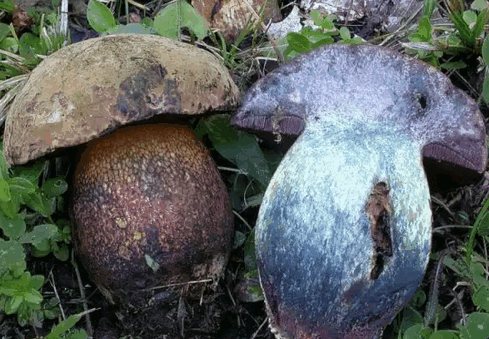
Sectional Dubovik
The hat has a hemispherical shape with wavy edges, velvety in texture. The leg of the oak tree is massive, thickened from below, from 5 cm to 12 cm in height, and 4-6 cm in thickness. The pulp is white, but when pressed, it acquires a blue tint. For this he received a second name - a bruise. You can see what a cutaway oak tree looks like in the photo.
Place of distribution
Most often, subdubovik is found in mixed and deciduous forests of a temperate climatic zone. Poddubnik prefers calcareous soils. Grows in places with good lighting and high humidity. Dubovik can be found near oaks, lindens, birches, but it can also grow in open areas, such as fields.
This species also lives on rocky surfaces. Most of the oak groves are found in oak groves. This species is characterized by group growth, which greatly facilitates collection. Bruises can be found from mid-summer to September, and the peak is in mid-August.
Eating
It is very important to learn how to clearly determine whether a given mushroom belongs to edible species or not, since many subspecies of oak tree that are similar to it are poisonous. The poddubnik itself belongs to the conditionally edible class

Eating poddubnik for food
This means that it needs to be thoroughly cooked before being cooked and eaten. To do this, it is first boiled in boiling water for 15-20 minutes, after which you can start cooking. The taste is very similar to porcini mushroom, because it is also often salted, fried and pickled.
Answers to common questions
The most common questions include questions about the toxicity and beneficial properties of the mushroom:
In oak forests grows an oak mushroom, some also call it poddubnik. gib-oak tree is very similar to boletus, but, nevertheless, these are different mushrooms.
Read also Tomatoes early ripening undersized cold-resistant

With regard to the oak mushroom and its description of the appearance, that is, the cap and legs, I will cite a quote from special sources.
It is noteworthy that the oak mushroom is considered a rather valuable mushroom and any mushroom picker will be happy to find it, however, there is a clarification that eating this mushroom in any form in conjunction with alcohol can lead to an upset stomach. In such an interesting fact.
With regards to eating in general, it is advisable to boil a little oak mushroom before cooking.
There is another type of mushroom that grows in oak forests. This is a speckled oak mushroom.
Yes, yes, there are such
Poddubovik (Dubovik) - can be found in forests, where oak trees grow predominantly, from June to September.There are two types: common oak tree and speckled oak tree. They differ in that the leg of the speckled subductor is covered with a small pattern in the form of reddish droplets, the foot of the common subductor has no pattern. These mushrooms taste exactly the same. The pulp of the poddubovik is dense, lemon-colored, practically odorless and tasteless. Cutting the mushroom quickly turns blue. But, when boiled, the pulp returns to its natural creamy color. It is consumed both fresh and pickled or dried.
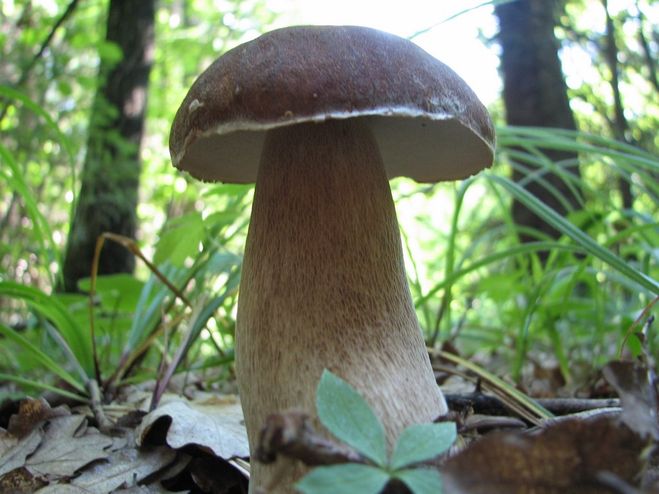
Podduboviks have a poisonous twin, a satanic mushroom. In a poisonous mushroom, the cap is almost always greenish, the flesh has an unpleasant rotten smell. If you break it, then the inner part at the break first turns red, and then gradually turns blue.
Deciduous forests can consist of one species of deciduous trees - birch groves, aspen forests, oak forests - or a mixture of species. Homogeneous deciduous forests are characterized by species of fungi that live in symbiosis with this tree species.
Where and when it grows
Mushrooms of various species grow in our forests and groves almost everywhere. Under natural conditions, they form mycorrhiza not only with oak, but also with other deciduous tree species, including birch and beech. However, most often these mushrooms can be found precisely in the oak forest, where calcareous soils predominate.

Boletus luridus is a very thermophilic fungus, therefore, it is quite rare in the forests of the northern regions and areas with unstable weather in the spring and summer. The harvesting season for this species is from July to September, and the peak of fruiting is observed in the last summer month. The yellow oak tree or boletus of the Boletus junquilleus species is practically not found in the European part of our country.
Beneficial features
The beneficial properties of this mushroom are due to its rich and varied composition. The pulp contains vitamins A, C, B1 and B2, dietary fiber, fats, proteins, nutrients and trace elements. Therefore, using such mushrooms is good for the whole body.
Fiber promotes high-quality bowel cleansing (works like a natural broom), normalizes metabolic processes and lowers blood sugar levels.
Doctors note the benefits of the product for those who want to lose weight, since 100 g contains only 34 kcal.
With regular use of fruit bodies, hemoglobin increases and hormonal levels stabilize.
Boiled mushrooms help to fill the lack of zinc, magnesium and copper.
Dubovik kele - description, where it grows, the poisonousness of the mushroom
The Kele oak mushroom belongs to the Boletovye family. They are edible.
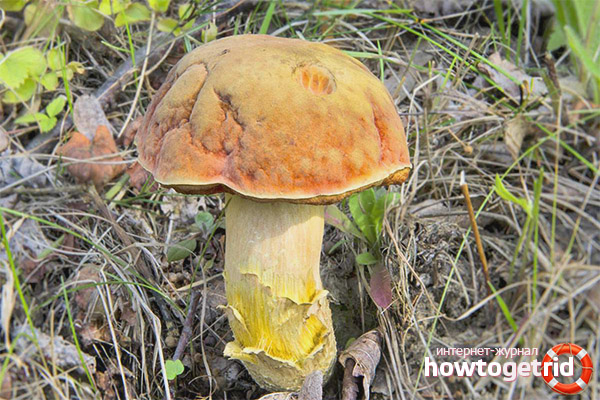
Appearance
The shape of the cap is convex, without tubercles. It can be different in size, in diameter - 6-14 cm. The color is brown, sometimes has a yellowish tint. The surface is matte, but after rain or in wet weather it becomes slippery and smooth.
The leg is firm and dense. In the lower part, it is somewhat swollen. The height varies from 6 to 11 cm. Usually the leg is colored yellow, on the surface there are small red scales. White mycelium is visible at the base. When pressed, the leg turns a little blue.
The flesh of this species is dense, yellow. When broken, it quickly turns blue. In this pulp, insect larvae are extremely rare. Has a faint smell and a slightly sour taste.
Inedible doubles
In appearance, the oak tree is very similar to the satanic mushroom. It is very dangerous to mix them up, since satanic is very poisonous. A distinctive feature of Kele's oak tree is that its flesh turns blue when damaged. He also has red pores, and red specks are visible on the leg.
Satanic mushroom can be distinguished by its pronounced strong odor. His hat is green with a gray tint. When damaged, the pulp also acquires a blue color, but soon it returns to its original color again.The satanic mushroom has a tuberous stem, which is usually thicker than that of an oak tree. A mesh pattern is visible on it.
Cooking use
This mushroom can be eaten, but only cooked. They must be processed thermally. Only after this will the substances that irritate the organs of the digestive system leave it.
These mushrooms are very nutritious, therefore they are widely used in cooking. They have a fleshy flesh and a pleasant smell. They are often salted, pickled, added to sauce, soup. To keep them longer, they are dried or frozen. But before you put them in the freezer, you need to boil them. They hardly boil down, retain useful substances.
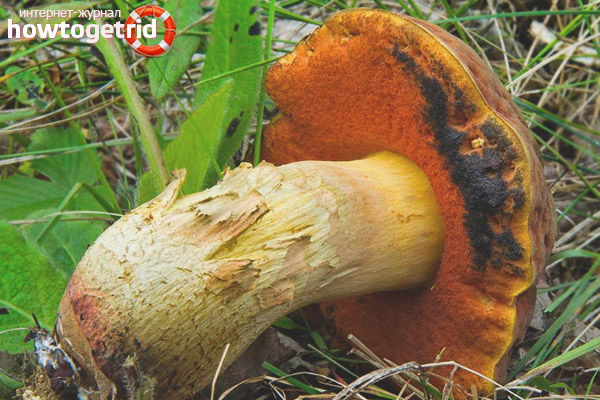
Amino acids improve memory and prevent atherosclerosis. Tinctures and other remedies are made from these mushrooms.
Precautionary measures
Since any mushrooms contain chitin, which children cannot digest, it is better to start using them only after 12 years.
Before use, it is recommended to soak the oak tree, draining the water several times. If this is not done, then the substances contained in these mushrooms will have a bad effect on digestion.
What related mushrooms exist
Burroughs boletus is also a usable relative of the oak tree. His hat is large and fleshy. At first it is round, and then it becomes flat. It can be white or gray. Sometimes there are specimens with a brownish cap. The stem is white and the flesh is quite firm. It has a rather pronounced aroma, and their taste is sweetish. You can see representatives of this species in the forest. They grow in North America. They often grow in large groups. They don't grow in Europe.
Growing at home and in the country
Dirty-brown boletus is a mycorrhizal fungus, which means that it can be grown in a summer cottage, but provided that there is an oak or birch. The simplest, most effective and less costly way is to cultivate oak tree from ready-made mycelium. It can be purchased at specialized gardening stores.
The growing process in a summer cottage consists of the following stages:
- Choose a tree under which the mushrooms will grow. This should be a shaded area of 2.5–3 m².
- Dig a hole 30 cm deep and fill it with nutrient mixture.
- Line the bottom with 10 cm of foliage, grass or wood bark.
- Cover with dung or soil taken under the tree.
- Spread the mycelium evenly, which should be premixed with 1 kg of soil.
- Place fallen leaves on top.
- The last layer is garden soil.
- Moisturize with a drip method.
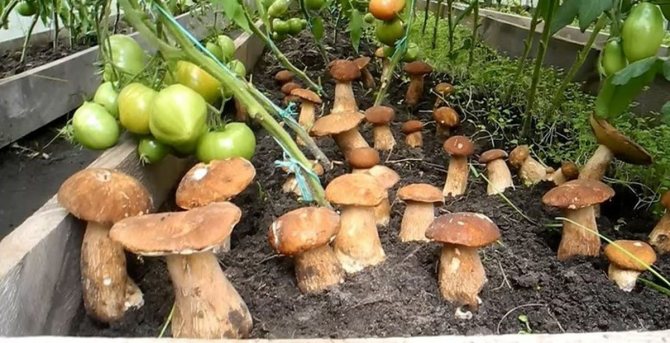
The first fruiting bodies will appear after 1–1.5 months, and then the crops will ripen every week. The fruiting period lasts from May to October. The mycelium lives up to 5 years. How to grow common oak tree indoors:
- Pour fertile soil mixed with mycelium into the boxes.
- Place containers in a well-ventilated place with direct sunlight. The room should have electric lighting 3-4 hours a day.
- Place containers of water near the drawers to maintain optimal humidity levels.
- Mushrooms grow at temperatures from 5 to 30 ºС (optimal - from 12 to 26).
Growing a mushroom
Many mushroom lovers or just summer residents want to have edible and tasty mushrooms in their garden, but few know where to start and how this process generally takes place.
There are two ways to grow an oak tree:
Extensive
Thanks to the first method of growing mushrooms, in which all conditions are as close to natural as possible, there are more chances to get a large harvest. This method does not require any special technique or any skills. The only bad thing is that it all depends on the weather conditions and the climate, if the weather is bad, then the mushrooms will be worse and slower to bear fruit.
It is necessary to plant oak mushrooms near deciduous trees, best of all near an oak tree.The plantation where the oak trees will grow should be protected from the sun, that is, direct rays should not fall. Around the tree is removed 20 centimeters in soil thickness of about one square meter. This place should be well watered, then sprinkled with soil prepared as follows:
- mix peat;
- leaves from a tree;
- sawdust;
- horse dung.
Mix everything with the soil and lay around the trunk. On top of this, sprinkle mycelium with dry soil and cover with native soil, removed earlier and "drip" water. In the hot summer months, the soil should be watered periodically, and in winter it should be insulated with moss, leaves that have fallen from wood and straw. You can start such a planting in spring or summer, if everything was done correctly, then after 6 months you can harvest the first crop.
Intensive
As for the second method, it is more effective, since the mushrooms will bear fruit regardless of the climate and weather conditions. The downside is some complexity and investment in this business. It is necessary to equip the mycelium so that there is always optimal humidity, temperature and lighting.
The mycelium must be sown on previously prepared healthy and moist wood. You can cut it 4 days before planting the mushrooms. Then the holes are cut out, and the mycelium is evenly poured into them. You can sow mycelium and pick mushrooms all year round, even in winter. The tree will bear fruit until the mycelium completely destroys it.
Although it is difficult to find an oak tree in the forest, every mushroom picker must put it in his basket and take it home. Everyone should try it, because it is not only tasty and aromatic, but also benefits the body, since it contains many vitamins and microelements. It will improve memory, increase immunity and simply add vigor and strength.
The oak mushroom is also called poddubnik, as it grows mainly in deciduous forests, namely, in oak groves. Outwardly, the oak tree resembles such a well-known and popular mushroom as boletus. But there are a number of differences between these forest dwellers.
| Latin name: | Suillellus luridus |
| English name: | To be specified |
| Domain: | Eukaryotes |
| Kingdom: | Mushrooms |
| Department: | Basidiomycetes |
| Class: | Agaricomycetes |
| Order: | Boletovye |
| Family: | Boletovye |
| Genus: | Borovik |
| Edibility | Edible mushroom |



